Abstract
Coryneform isolates from clinical specimens frequently cannot be identified by either reference laboratories or research laboratories. Many of these organisms are skin flora that belong to a large number of taxonomic groups, only 40% of which are in the genus Corynebacterium. This review provides an update on clinical presentations, microbiological features, and pathogenic mechanisms of infections with nondiphtheria Corynebacterium species and other pleomorphic gram-positive rods. The early literature is also reviewed for a few coryneforms, especially those whose roles as pathogens are controversial. Recognition of newly emerging opportunistic coryneforms is dependent on sound identification schemes which cannot be developed until cell wall analyses and nucleic acid studies have defined the taxonomic groups and all of the reference strains within each taxon have been shown by molecular methods to be authentic members. Only then can reliable batteries of biochemical tests be selected for distinguishing each taxon.
Full text
PDF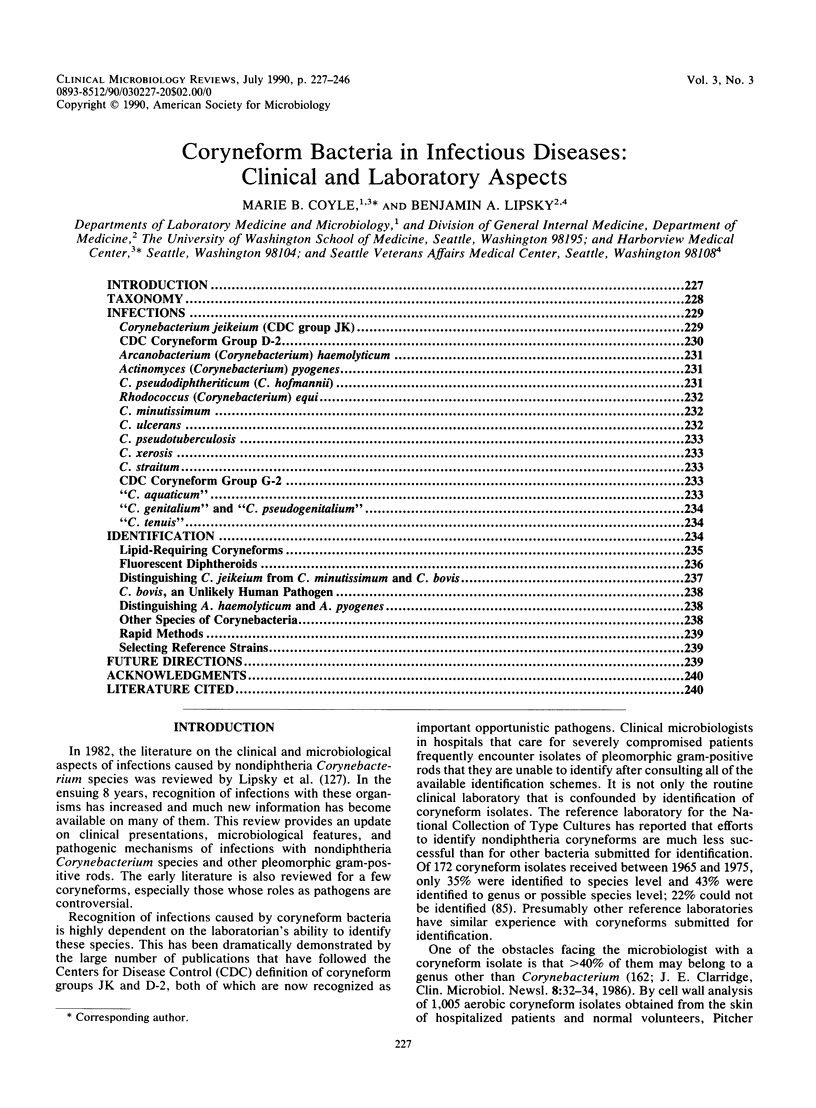
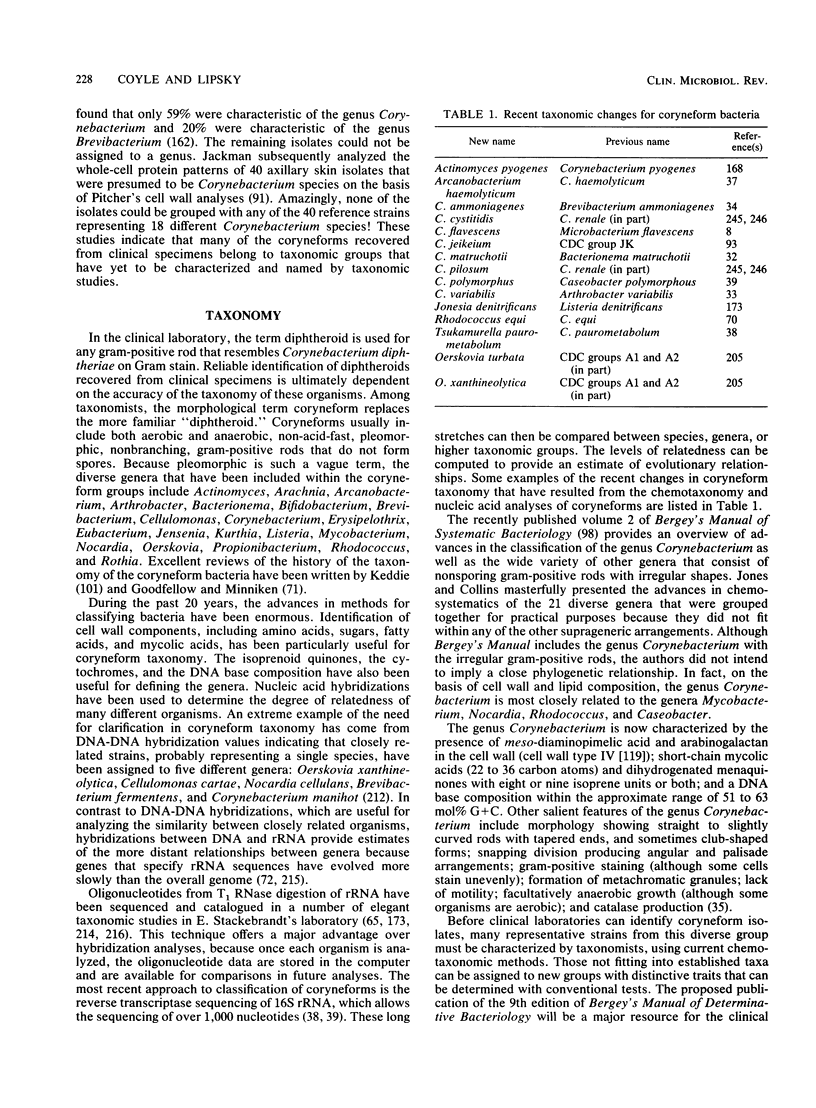
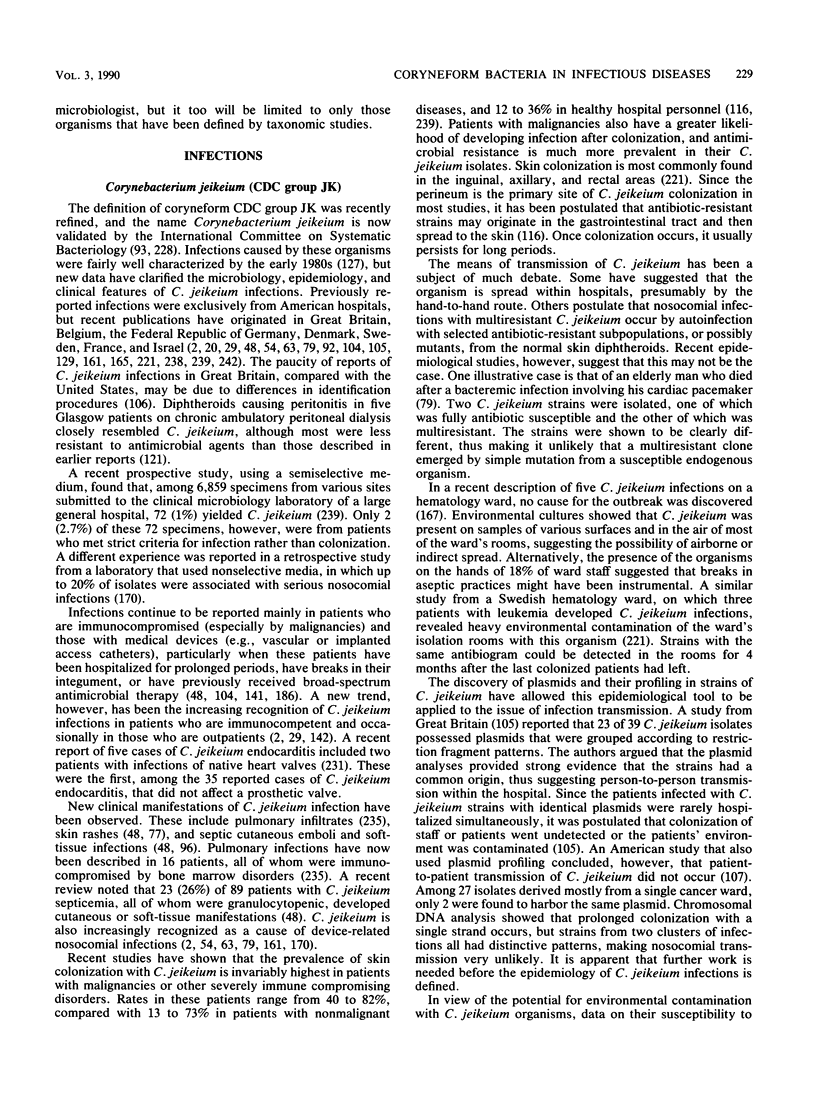
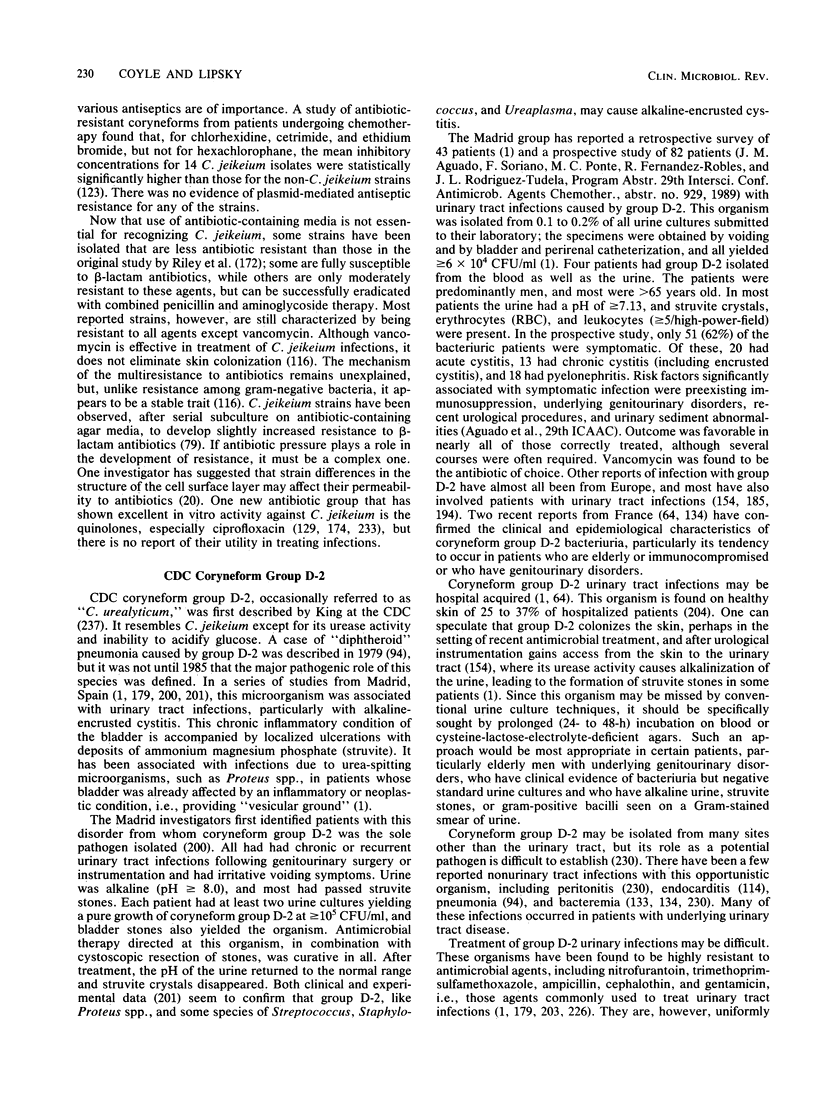
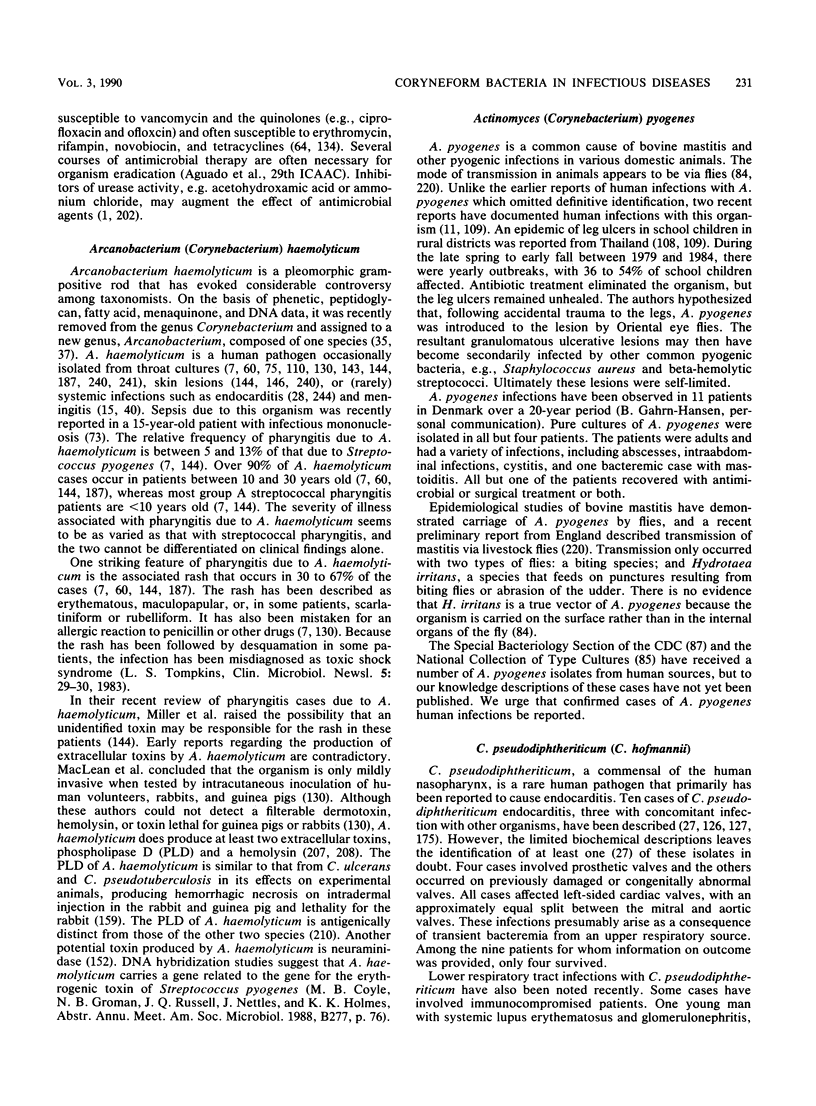
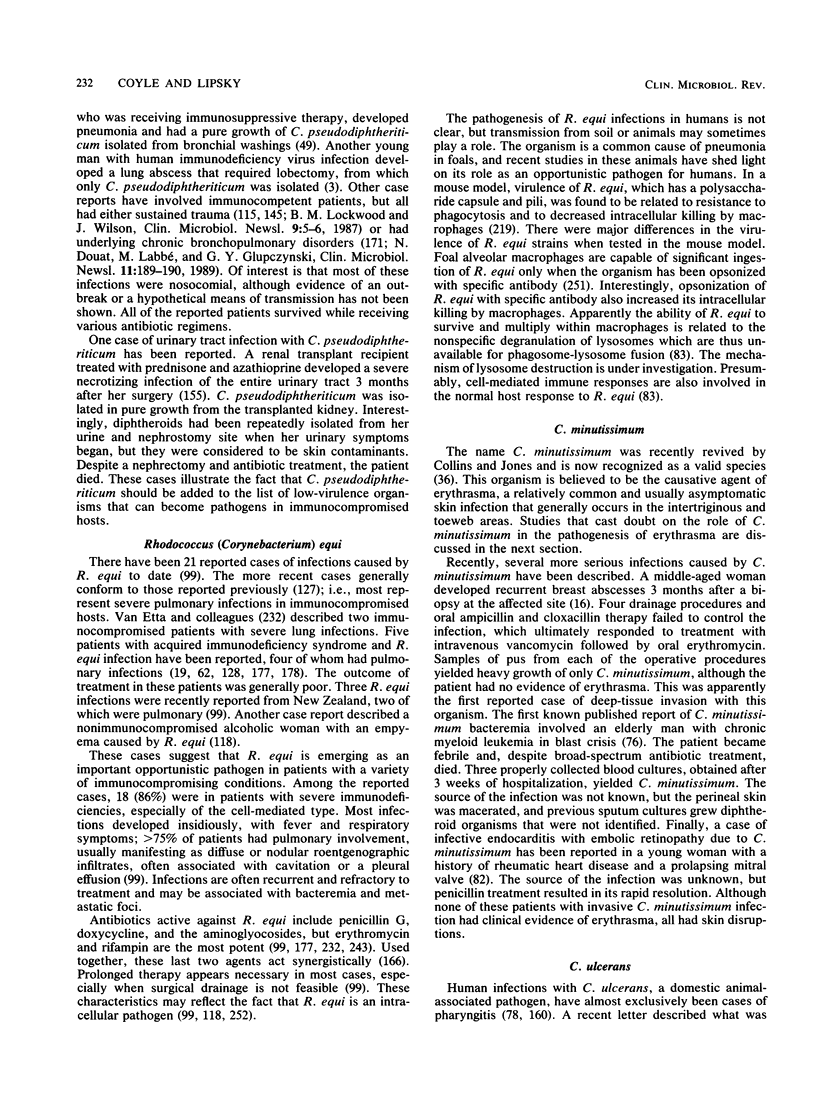
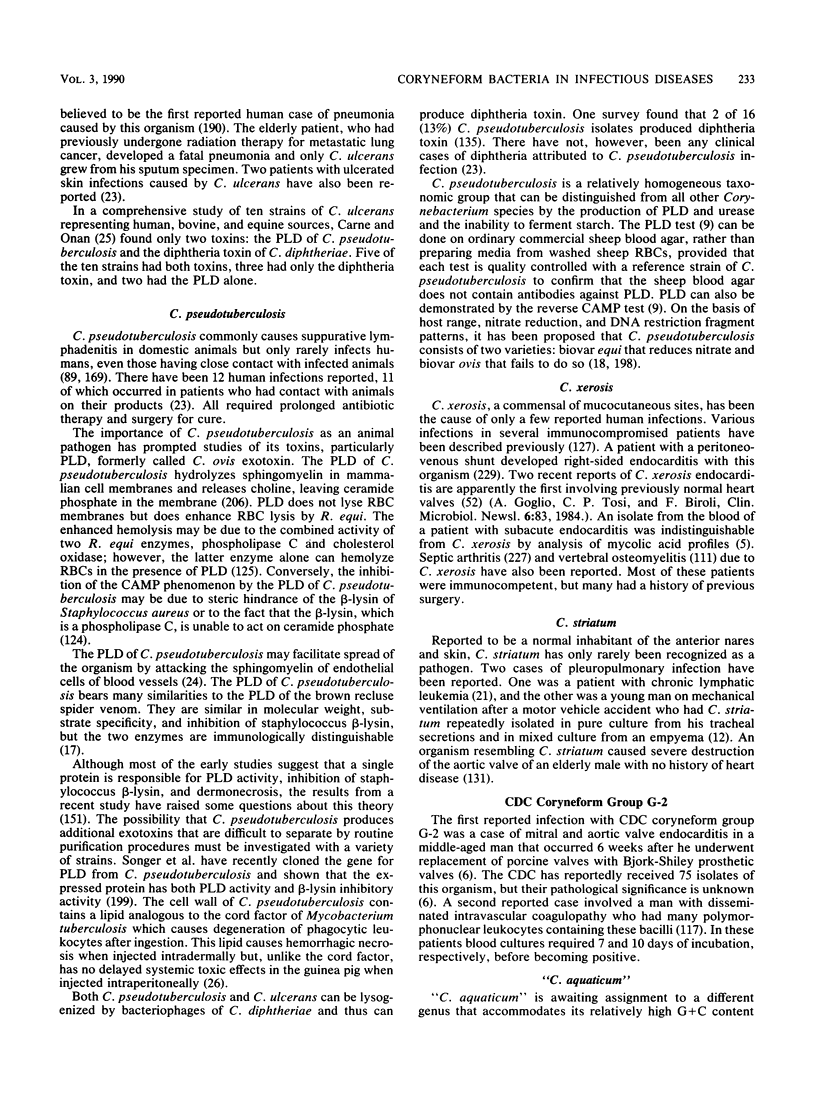
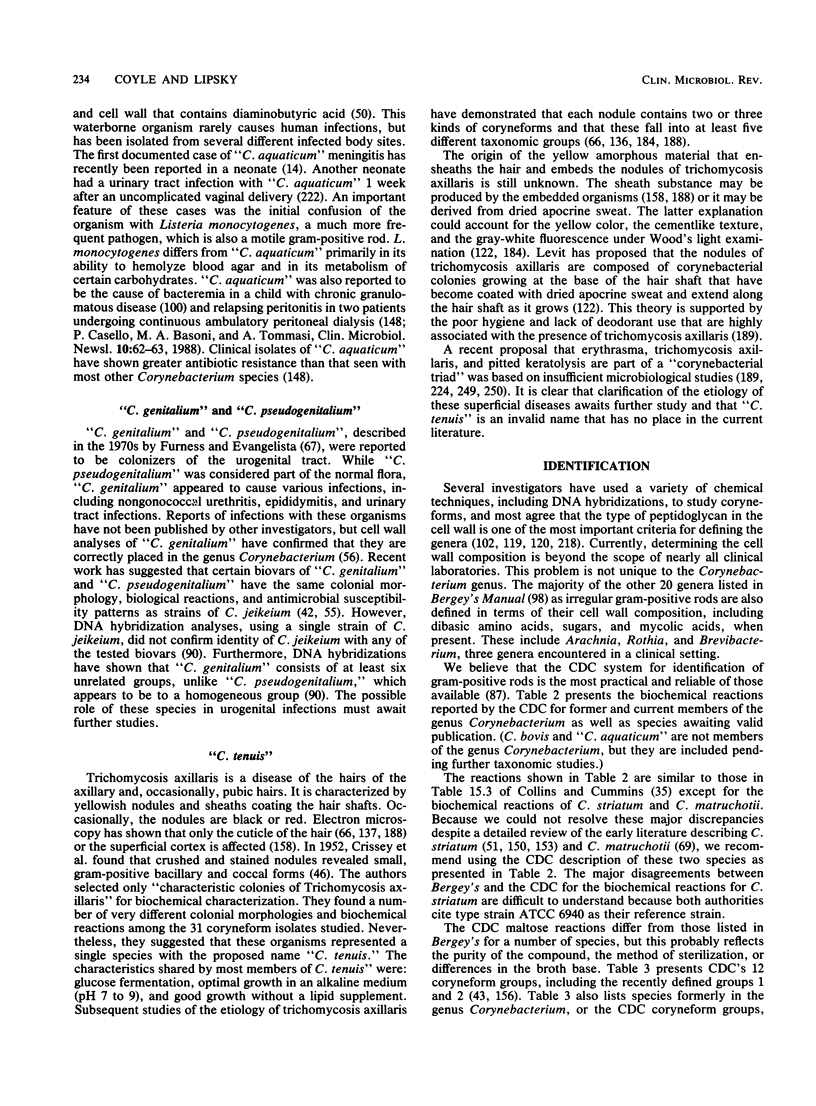
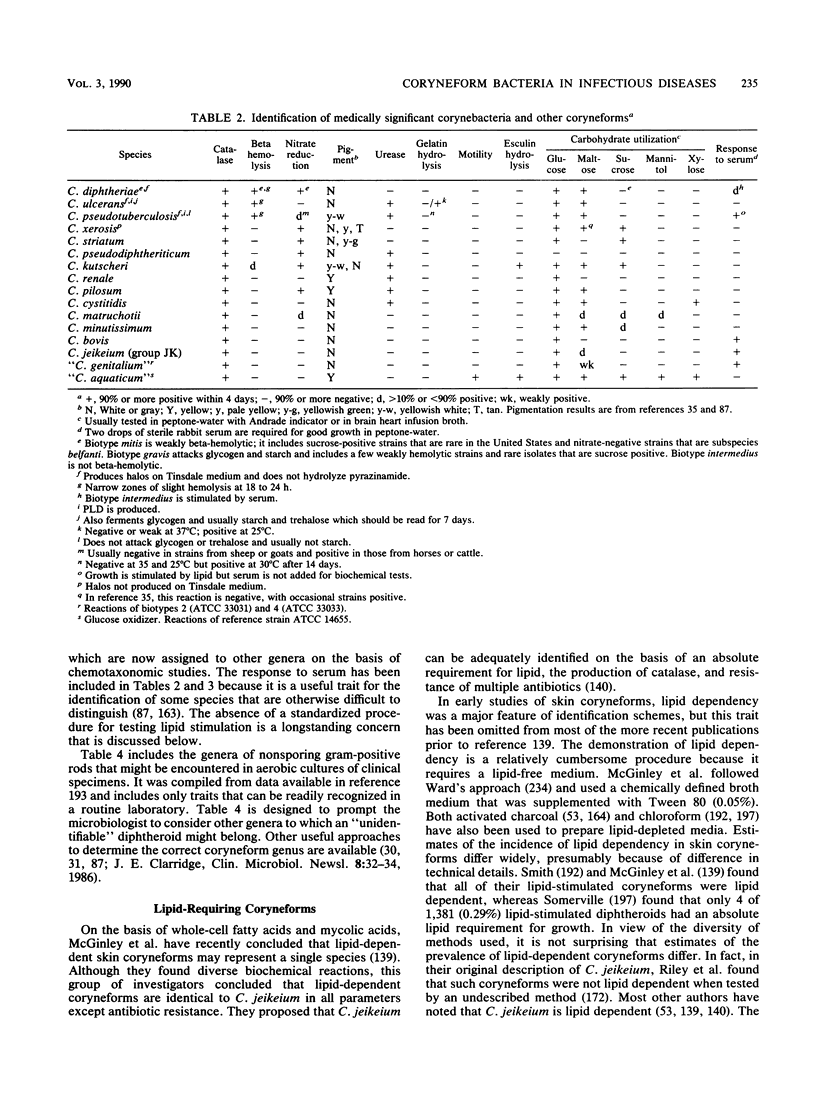
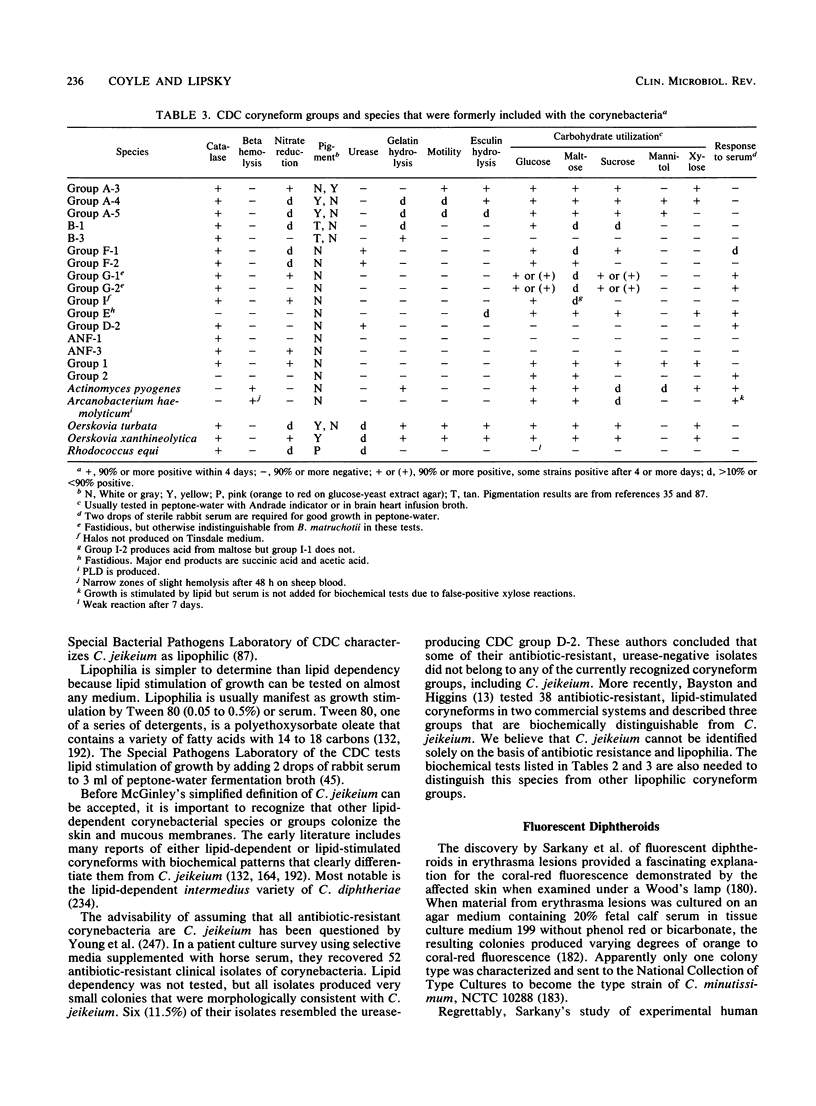
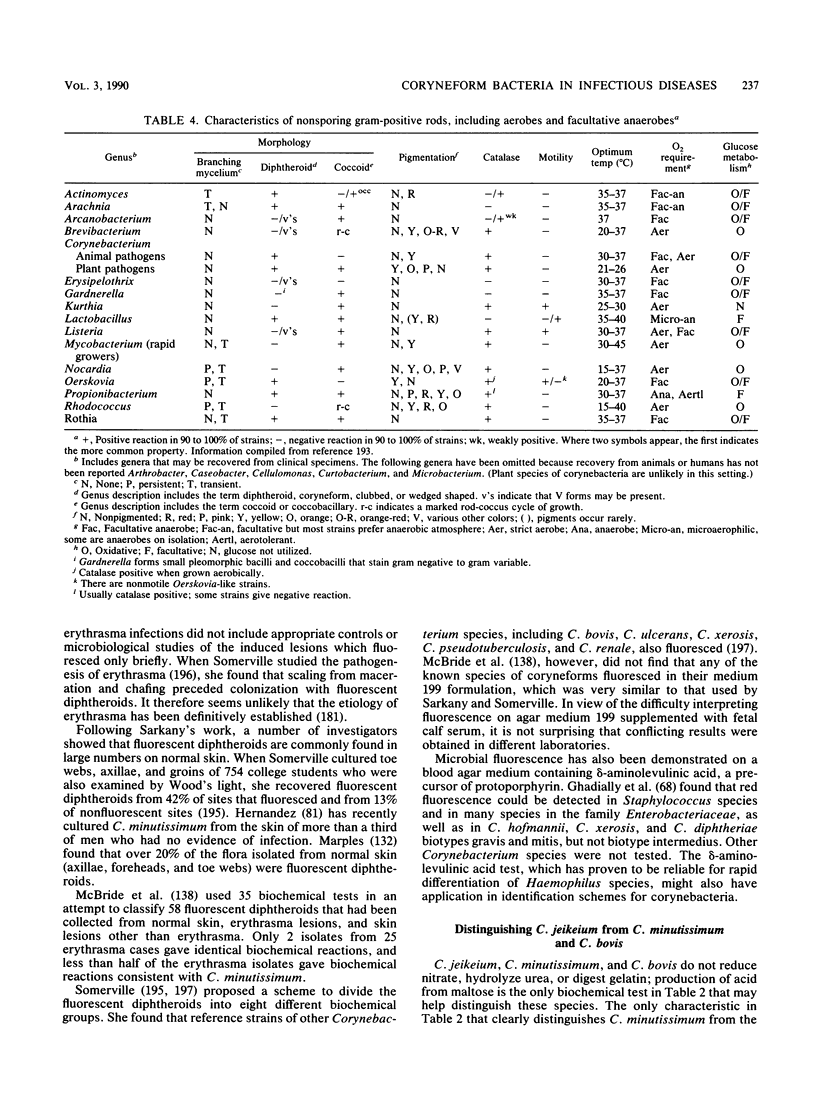
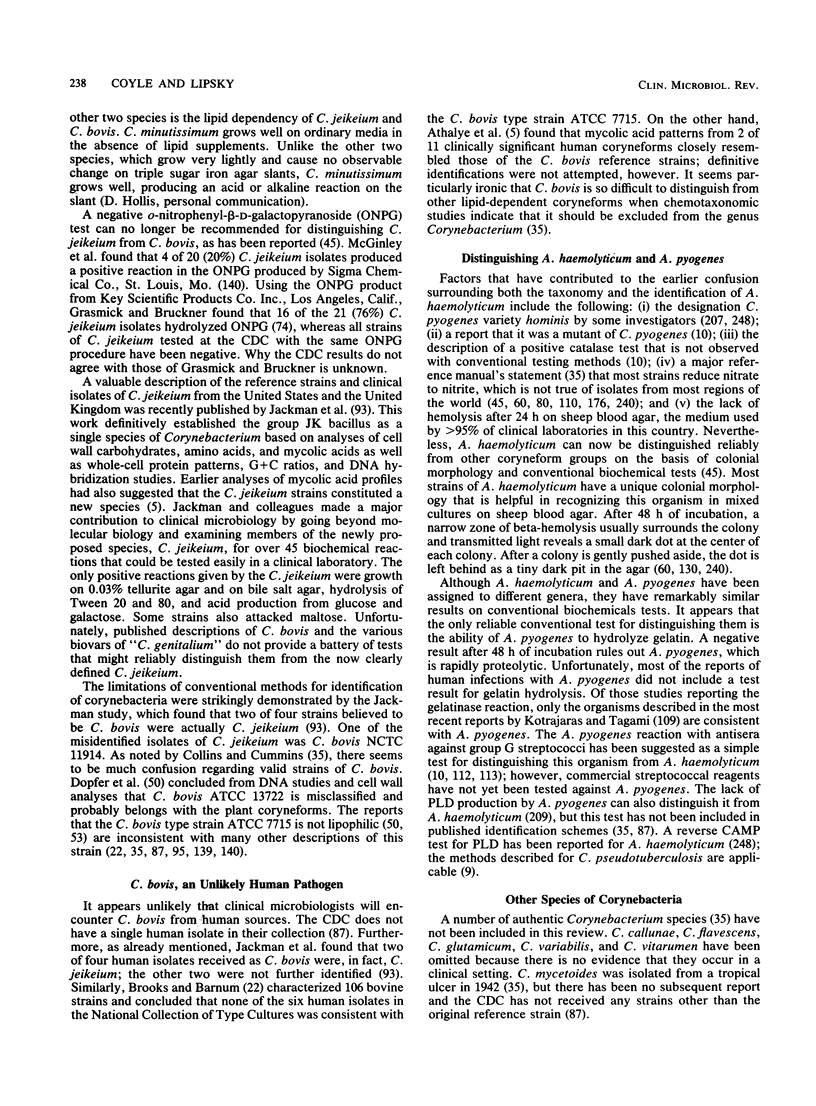
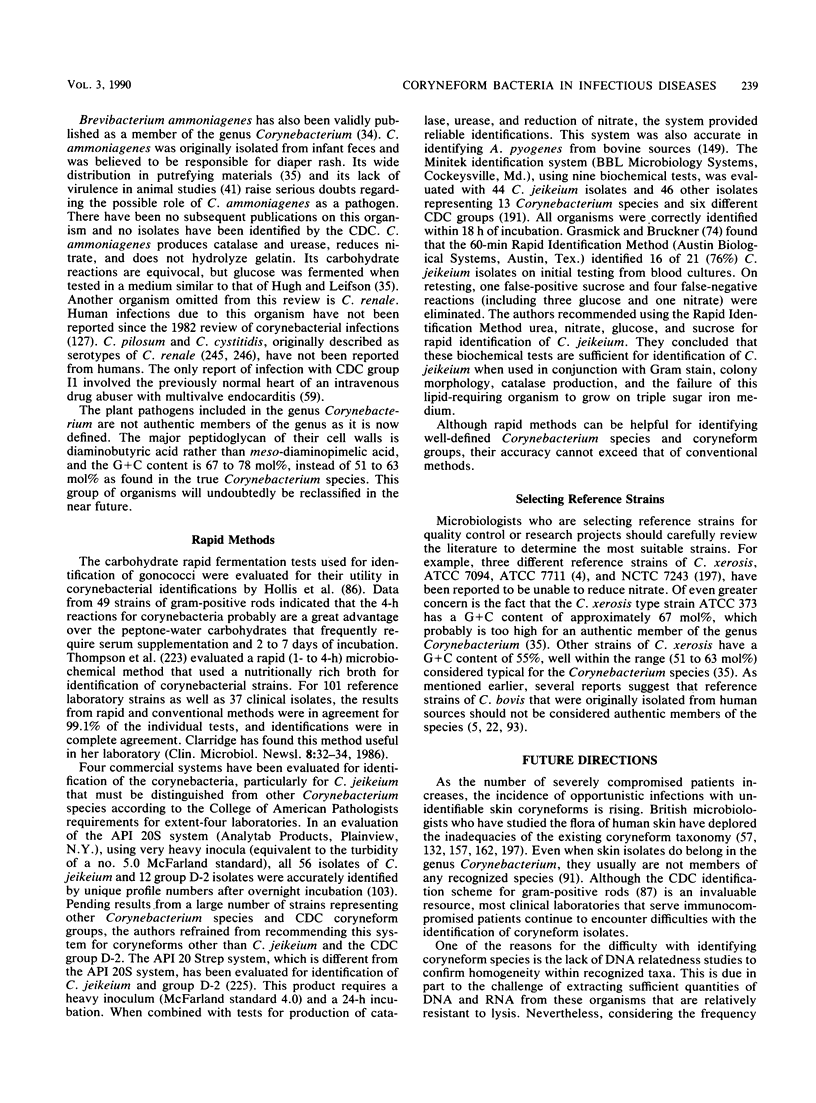
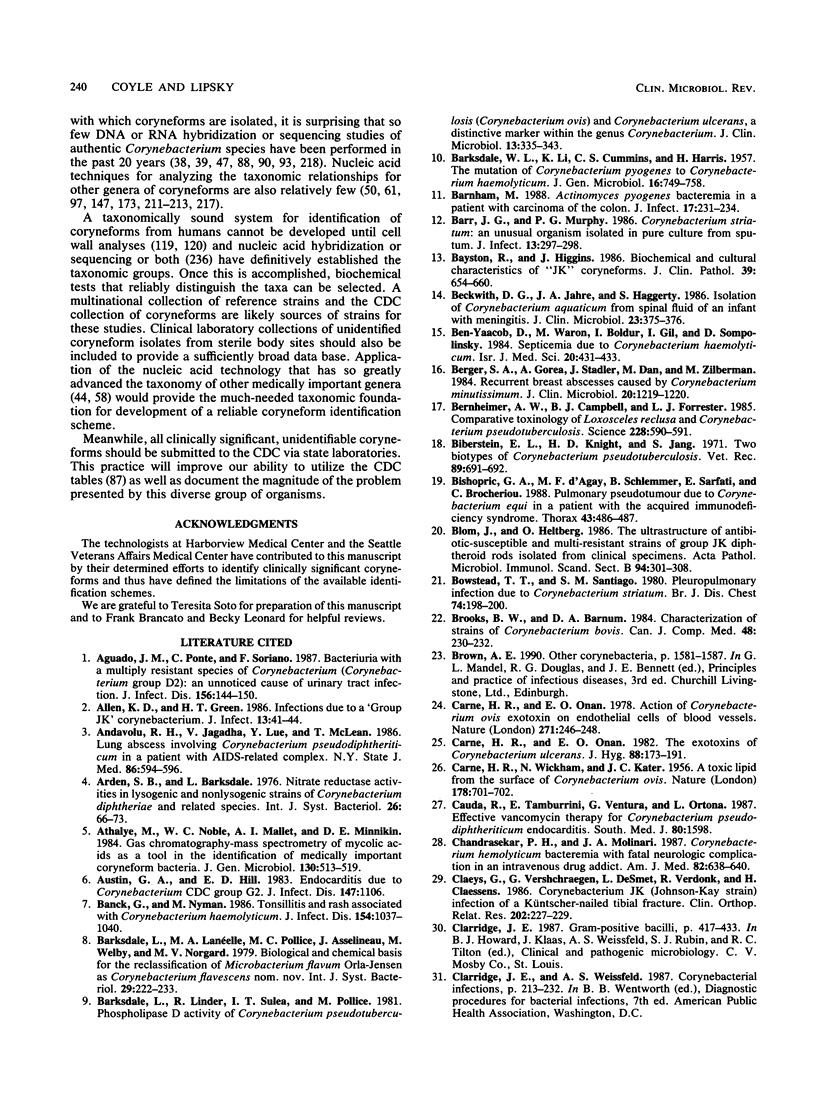
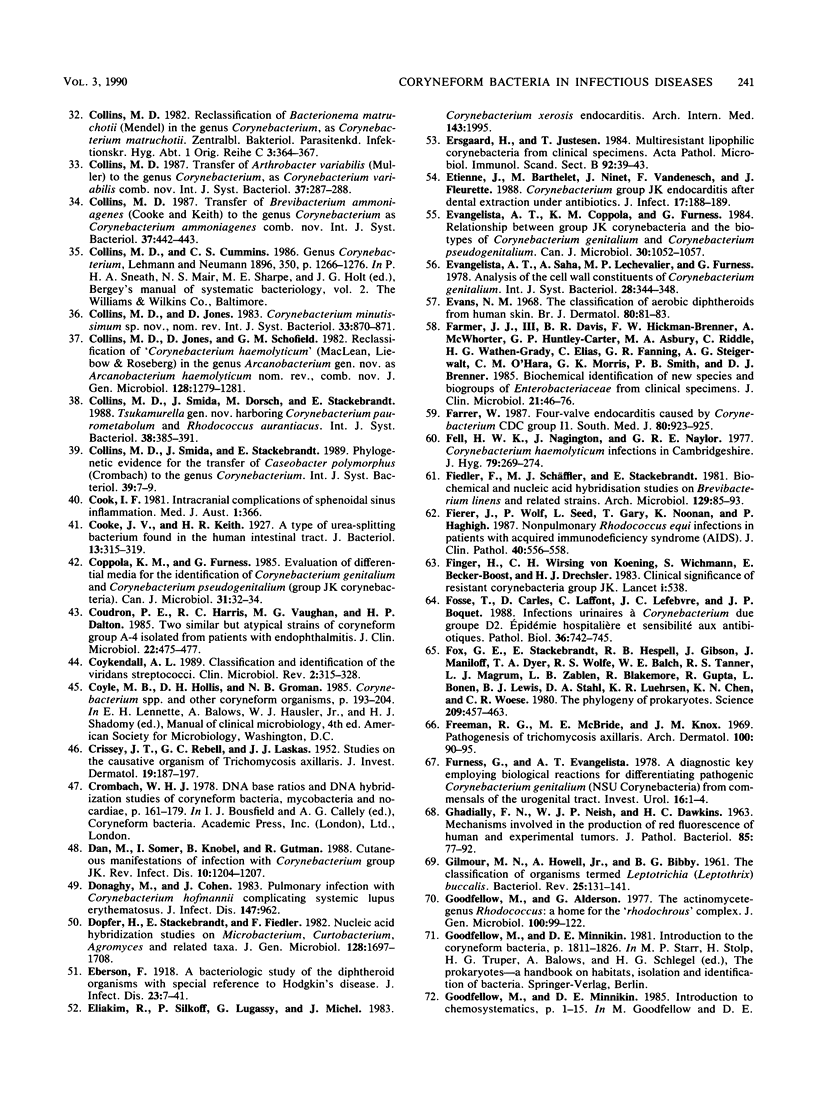
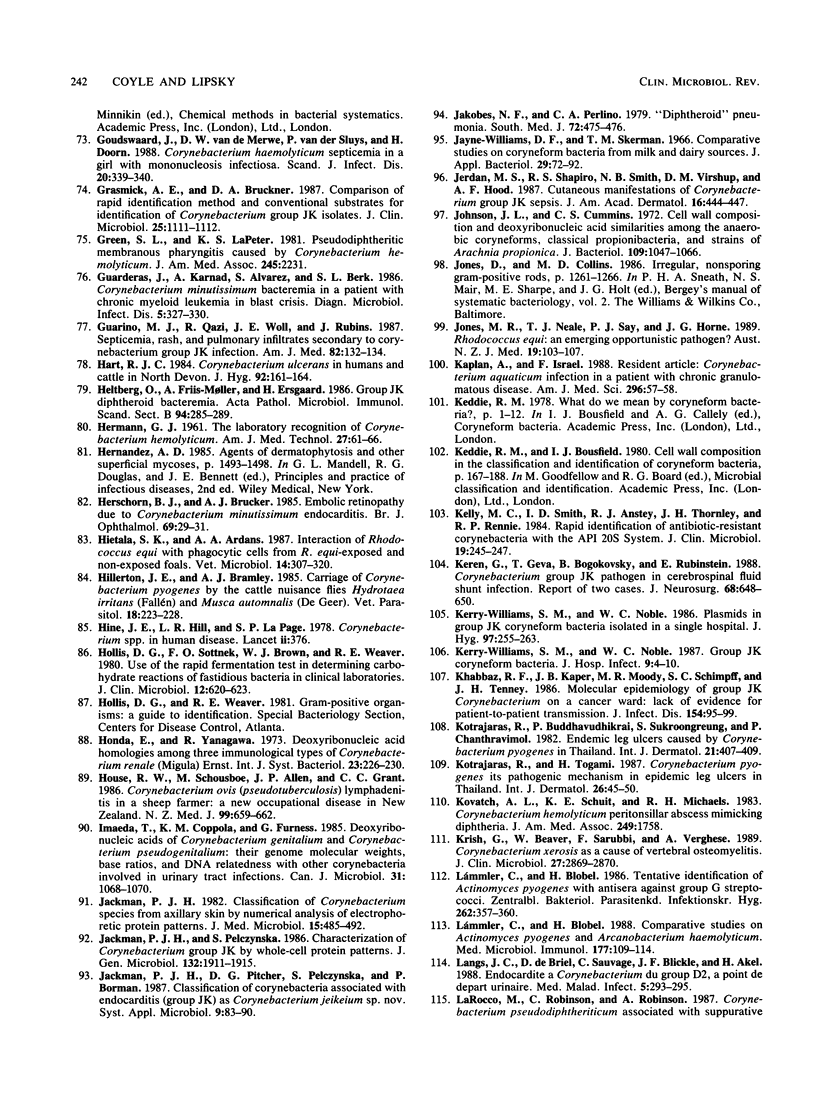
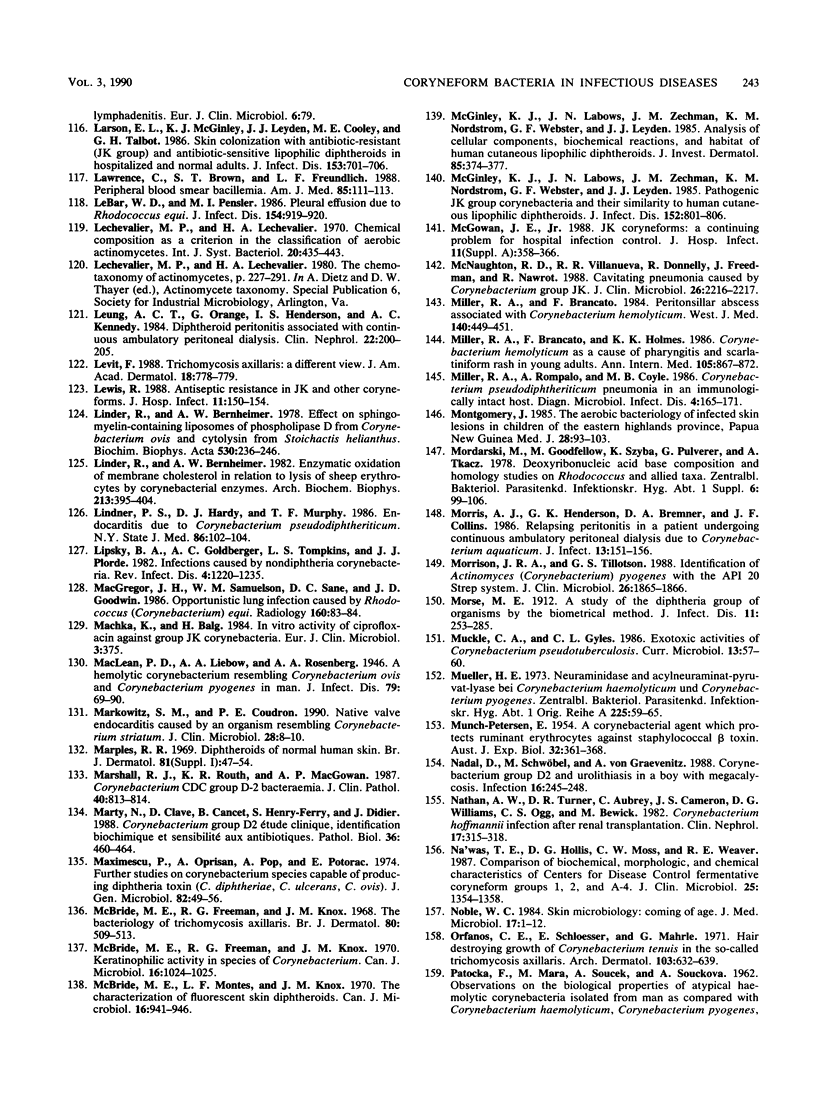
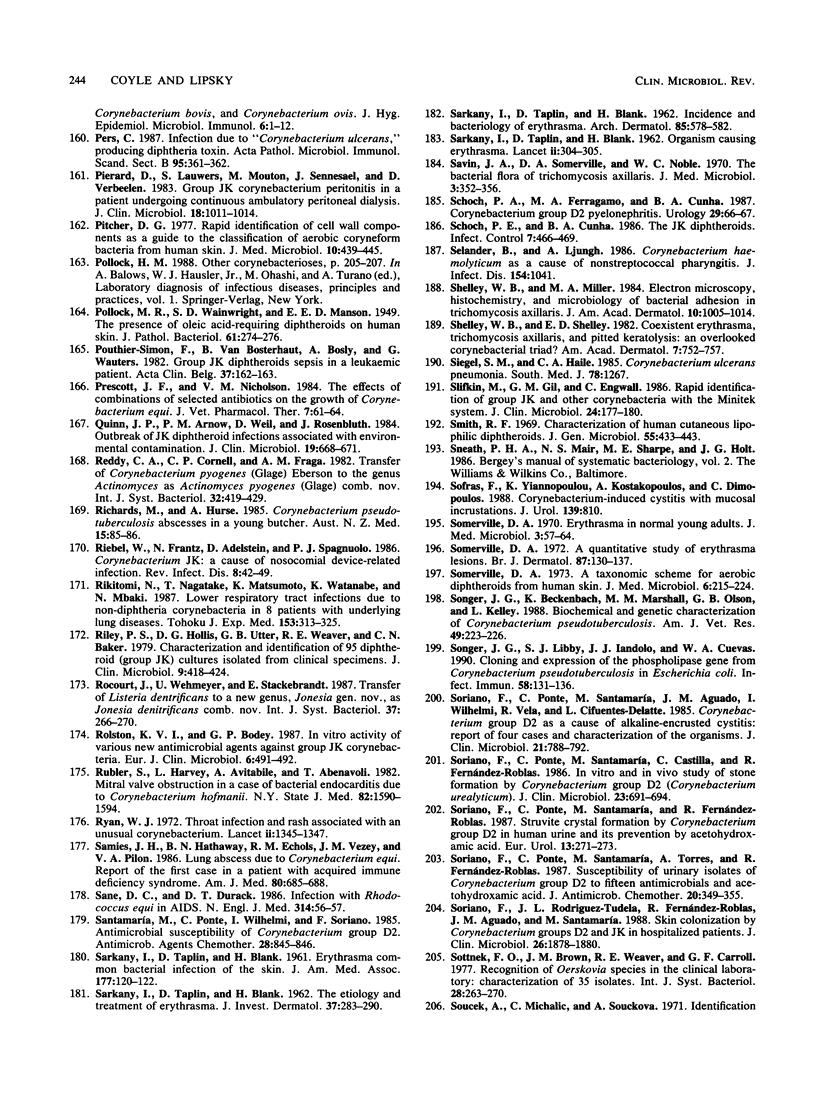
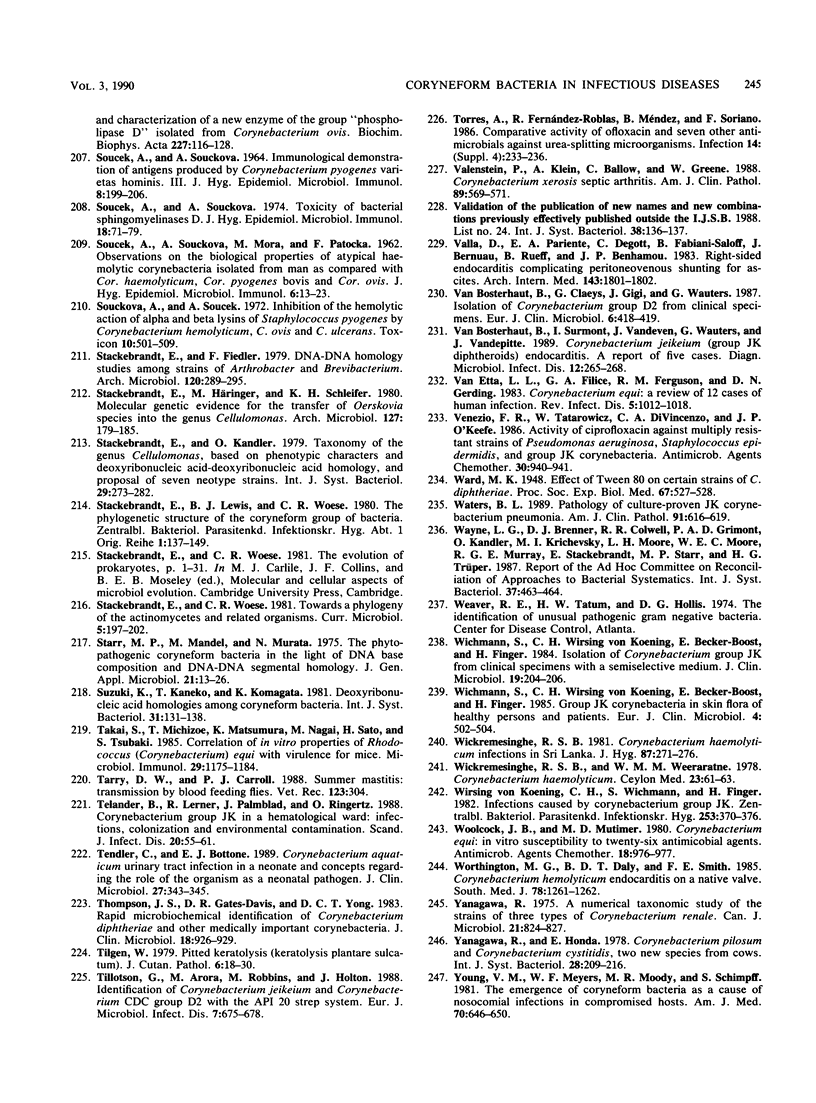
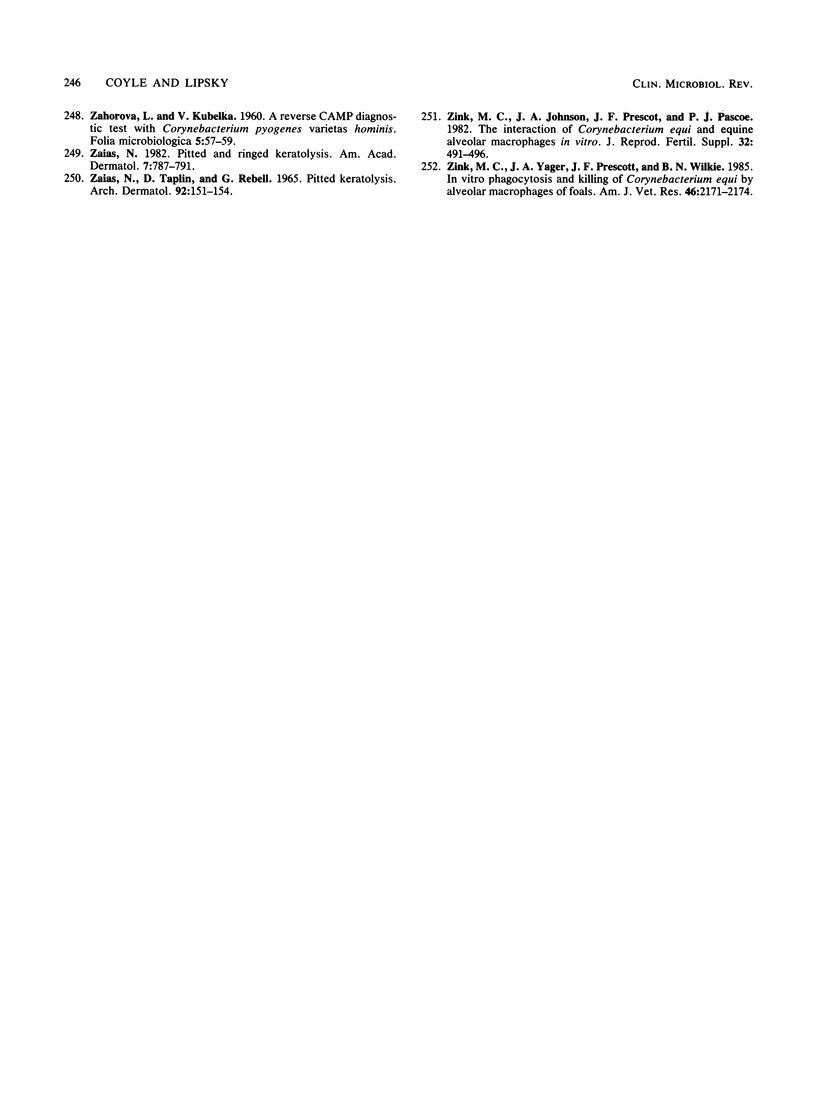
Selected References
These references are in PubMed. This may not be the complete list of references from this article.
- Aguado J. M., Ponte C., Soriano F. Bacteriuria with a multiply resistant species of Corynebacterium (Corynebacterium group D2): an unnoticed cause of urinary tract infection. J Infect Dis. 1987 Jul;156(1):144–150. doi: 10.1093/infdis/156.1.144. [DOI] [PubMed] [Google Scholar]
- Allen K. D., Green H. T. Infections due to a 'Group JK' corynebacterium. J Infect. 1986 Jul;13(1):41–44. doi: 10.1016/s0163-4453(86)92256-5. [DOI] [PubMed] [Google Scholar]
- Andavolu R. H., Jagadha V., Lue Y., McLean T. Lung abscess involving Corynebacterium pseudodiphtheriticum in a patient with AIDS-related complex. N Y State J Med. 1986 Nov;86(11):594–596. [PubMed] [Google Scholar]
- Athalye M., Noble W. C., Mallet A. I., Minnikin D. E. Gas chromatography-mass spectrometry of mycolic acids as a tool in the identification of medically important coryneform bacteria. J Gen Microbiol. 1984 Mar;130(3):513–519. doi: 10.1099/00221287-130-3-513. [DOI] [PubMed] [Google Scholar]
- Austin G. E., Hill E. O. Endocarditis due to Corynebacterium CDC group G2. J Infect Dis. 1983 Jun;147(6):1106–1106. doi: 10.1093/infdis/147.6.1106. [DOI] [PubMed] [Google Scholar]
- BARKSDALE W. L., LI K., CUMMINS C. S., HARRIS H. The mutation of Corynebacterium pyogenes to Corynebacterium haemolyticum. J Gen Microbiol. 1957 Jun;16(3):749–758. doi: 10.1099/00221287-16-3-749. [DOI] [PubMed] [Google Scholar]
- Banck G., Nyman M. Tonsillitis and rash associated with Corynebacterium haemolyticum. J Infect Dis. 1986 Dec;154(6):1037–1040. doi: 10.1093/infdis/154.6.1037. [DOI] [PubMed] [Google Scholar]
- Barksdale L., Linder R., Sulea I. T., Pollice M. Phospholipase D activity of Corynebacterium pseudotuberculosis (Corynebacterium ovis) and Corynebacterium ulcerans, a distinctive marker within the genus Corynebacterium. J Clin Microbiol. 1981 Feb;13(2):335–343. doi: 10.1128/jcm.13.2.335-343.1981. [DOI] [PMC free article] [PubMed] [Google Scholar]
- Barnham M. Actinomyces pyogenes bacteraemia in a patient with carcinoma of the colon. J Infect. 1988 Nov;17(3):231–234. doi: 10.1016/s0163-4453(88)96522-x. [DOI] [PubMed] [Google Scholar]
- Barr J. G., Murphy P. G. Corynebacterium striatum: an unusual organism isolated in pure culture from sputum. J Infect. 1986 Nov;13(3):297–298. doi: 10.1016/s0163-4453(86)91454-4. [DOI] [PubMed] [Google Scholar]
- Bayston R., Higgins J. Biochemical and cultural characteristics of "JK" coryneforms. J Clin Pathol. 1986 Jun;39(6):654–660. doi: 10.1136/jcp.39.6.654. [DOI] [PMC free article] [PubMed] [Google Scholar]
- Beckwith D. G., Jahre J. A., Haggerty S. Isolation of Corynebacterium aquaticum from spinal fluid of an infant with meningitis. J Clin Microbiol. 1986 Feb;23(2):375–376. doi: 10.1128/jcm.23.2.375-376.1986. [DOI] [PMC free article] [PubMed] [Google Scholar]
- Ben-Yaacob D., Waron M., Boldur I., Gil I., Sompolinsky D. Septicemia due to Corynebacterium haemolyticum. Isr J Med Sci. 1984 May;20(5):431–433. [PubMed] [Google Scholar]
- Berger S. A., Gorea A., Stadler J., Dan M., Zilberman M. Recurrent breast abscesses caused by Corynebacterium minutissimum. J Clin Microbiol. 1984 Dec;20(6):1219–1220. doi: 10.1128/jcm.20.6.1219-1220.1984. [DOI] [PMC free article] [PubMed] [Google Scholar]
- Bernheimer A. W., Campbell B. J., Forrester L. J. Comparative toxinology of Loxosceles reclusa and Corynebacterium pseudotuberculosis. Science. 1985 May 3;228(4699):590–591. doi: 10.1126/science.3983643. [DOI] [PubMed] [Google Scholar]
- Biberstein E. L., Knight H. D., Jang S. Two biotypes of Corynebacterium pseudotuberculosis. Vet Rec. 1971 Dec 25;89(26):691–692. doi: 10.1136/vr.89.26.691. [DOI] [PubMed] [Google Scholar]
- Bishopric G. A., d'Agay M. F., Schlemmer B., Sarfati E., Brocheriou C. Pulmonary pseudotumour due to Corynebacterium equi in a patient with the acquired immunodeficiency syndrome. Thorax. 1988 Jun;43(6):486–487. doi: 10.1136/thx.43.6.486. [DOI] [PMC free article] [PubMed] [Google Scholar]
- Blom J., Heltberg O. The ultrastructure of antibiotic-susceptible and multi-resistant strains of group JK diphtheroid rods isolated from clinical specimens. Acta Pathol Microbiol Immunol Scand B. 1986 Oct;94(5):301–308. doi: 10.1111/j.1699-0463.1986.tb03057.x. [DOI] [PubMed] [Google Scholar]
- Bowstead T. T., Santiago S. M. Pleuropulmonary infection due to Corynebacterium striatum. Br J Dis Chest. 1980 Apr;74(2):198–200. doi: 10.1016/0007-0971(80)90035-2. [DOI] [PubMed] [Google Scholar]
- Brooks B. W., Barnum D. A. Characterization of strains of Corynebacterium bovis. Can J Comp Med. 1984 Apr;48(2):230–232. [PMC free article] [PubMed] [Google Scholar]
- CARNE H. R., KATER J. C., WICKHAM N. A toxic lipid from the surface of Corynebacterium ovis. Nature. 1956 Sep 29;178(4535):701–702. doi: 10.1038/178701a0. [DOI] [PubMed] [Google Scholar]
- CRISSEY J. T., REBELL G. C., LASKAS J. J. Studies on the causative organism of trichomycosis axillaris. J Invest Dermatol. 1952 May;19(3):187–197. doi: 10.1038/jid.1952.84. [DOI] [PubMed] [Google Scholar]
- Carne H. R., Onon E. O. Action of Corynebacterium ovis exotoxin on endothelial cells of blood vessels. Nature. 1978 Jan 19;271(5642):246–248. doi: 10.1038/271246a0. [DOI] [PubMed] [Google Scholar]
- Carne H. R., Onon E. O. The exotoxins of Corynebacterium ulcerans. J Hyg (Lond) 1982 Apr;88(2):173–191. doi: 10.1017/s0022172400070054. [DOI] [PMC free article] [PubMed] [Google Scholar]
- Cauda R., Tamburrini E., Ventura G., Ortona L. Effective vancomycin therapy for Corynebacterium pseudodiphtheriticum endocarditis. South Med J. 1987 Dec;80(12):1598–1598. doi: 10.1097/00007611-198712000-00033. [DOI] [PubMed] [Google Scholar]
- Chandrasekar P. H., Molinari J. A. Corynebacterium hemolyticum bacteremia with fatal neurologic complication in an intravenous drug addict. Am J Med. 1987 Mar 23;82(3 Spec No):638–640. doi: 10.1016/0002-9343(87)90114-8. [DOI] [PubMed] [Google Scholar]
- Claeys G., Vershchraegen G., DeSmet L., Verdonk R., Claessens H. Corynebacterium JK (Johnson-Kay strain) infection of a Küntscher-nailed tibial fracture. Clin Orthop Relat Res. 1986 Jan;(202):227–229. [PubMed] [Google Scholar]
- Collins M. D., Jones D., Schofield G. M. Reclassification of 'Corynebacterium haemolyticum' (MacLean, Liebow & Rosenberg) in the genus Arcanobacterium gen.nov. as Arcanobacterium haemolyticum nom.rev., comb.nov. J Gen Microbiol. 1982 Jun;128(6):1279–1281. doi: 10.1099/00221287-128-6-1279. [DOI] [PubMed] [Google Scholar]
- Cook I. F., Cabral D. A., Reed W. D., Bond R. J., Henderson A. Intracranial complications of sphenoidal sinus inflammation. Med J Aust. 1981 Apr 4;1(7):366–366. doi: 10.5694/j.1326-5377.1981.tb135637.x. [DOI] [PubMed] [Google Scholar]
- Cooke J. V., Keith H. R. A TYPE OF UREA-SPLITTING BACTERIUM FOUND IN THE HUMAN INTESTINAL TRACT. J Bacteriol. 1927 May;13(5):315–319. doi: 10.1128/jb.13.5.315-319.1927. [DOI] [PMC free article] [PubMed] [Google Scholar]
- Coppola K. M., Furness G. Evaluation of differential media for the identification of Corynebacterium genitalium and Corynebacterium pseudogenitalium (group JK corynebacteria). Can J Microbiol. 1985 Jan;31(1):32–34. doi: 10.1139/m85-008. [DOI] [PubMed] [Google Scholar]
- Coudron P. E., Harris R. C., Vaughan M. G., Dalton H. P. Two similar but atypical strains of coryneform group A-4 isolated from patients with endophthalmitis. J Clin Microbiol. 1985 Oct;22(4):475–477. doi: 10.1128/jcm.22.4.475-477.1985. [DOI] [PMC free article] [PubMed] [Google Scholar]
- Coykendall A. L. Classification and identification of the viridans streptococci. Clin Microbiol Rev. 1989 Jul;2(3):315–328. doi: 10.1128/cmr.2.3.315. [DOI] [PMC free article] [PubMed] [Google Scholar]
- Dan M., Somer I., Knobel B., Gutman R. Cutaneous manifestations of infection with Corynebacterium group JK. Rev Infect Dis. 1988 Nov-Dec;10(6):1204–1207. doi: 10.1093/clinids/10.6.1204. [DOI] [PubMed] [Google Scholar]
- Donaghy M., Cohen J. Pulmonary infection with Corynebacterium hofmannii complicating systemic lupus erythematosus. J Infect Dis. 1983 May;147(5):962–962. doi: 10.1093/infdis/147.5.962. [DOI] [PubMed] [Google Scholar]
- Döpfer H., Stackebrandt E., Fiedler F. Nucleic acid hybridization studies on Microbacterium, Curtobacterium, Agromyces and related taxa. J Gen Microbiol. 1982 Aug;128(8):1697–1708. doi: 10.1099/00221287-128-8-1697. [DOI] [PubMed] [Google Scholar]
- Eliakim R., Silkoff P., Lugassy G., Michel J. Corynebacterium xerosis endocarditis. Arch Intern Med. 1983 Oct;143(10):1995–1995. [PubMed] [Google Scholar]
- Ersgaard H., Justesen T. Multiresistant lipophilic corynebacteria from clinical specimens. Biochemical reactions and antimicrobial agents susceptibility. Acta Pathol Microbiol Immunol Scand B. 1984 Feb;92(1):39–43. [PubMed] [Google Scholar]
- Etienne J., Barthelet M., Ninet J., Vandenesch F., Fleurette J. Corynebacterium group JK endocarditis after dental extraction under antibiotic cover. J Infect. 1988 Sep;17(2):188–189. doi: 10.1016/s0163-4453(88)92047-6. [DOI] [PubMed] [Google Scholar]
- Evangelista A. T., Coppola K. M., Furness G. Relationship between group JK corynebacteria and the biotypes of Corynebacterium genitalium and Corynebacterium pseudogenitalium. Can J Microbiol. 1984 Aug;30(8):1052–1057. doi: 10.1139/m84-164. [DOI] [PubMed] [Google Scholar]
- Evans N. M. The classification of aerobic diphtheroids from human skin. Br J Dermatol. 1968 Feb;80(2):81–83. doi: 10.1111/j.1365-2133.1968.tb12264.x. [DOI] [PubMed] [Google Scholar]
- Farmer J. J., 3rd, Davis B. R., Hickman-Brenner F. W., McWhorter A., Huntley-Carter G. P., Asbury M. A., Riddle C., Wathen-Grady H. G., Elias C., Fanning G. R. Biochemical identification of new species and biogroups of Enterobacteriaceae isolated from clinical specimens. J Clin Microbiol. 1985 Jan;21(1):46–76. doi: 10.1128/jcm.21.1.46-76.1985. [DOI] [PMC free article] [PubMed] [Google Scholar]
- Farrer W. Four-valve endocarditis caused by corynebacterium CDC group I1. South Med J. 1987 Jul;80(7):923–925. doi: 10.1097/00007611-198707000-00031. [DOI] [PubMed] [Google Scholar]
- Fell H. W., Nagington J., Naylor G. R., Olds R. J. Corynebacterium haemolyticum infections in Cambridgeshire. J Hyg (Lond) 1977 Oct;79(2):269–274. doi: 10.1017/s0022172400053080. [DOI] [PMC free article] [PubMed] [Google Scholar]
- Fierer J., Wolf P., Seed L., Gay T., Noonan K., Haghighi P. Non-pulmonary Rhodococcus equi infections in patients with acquired immune deficiency syndrome (AIDS). J Clin Pathol. 1987 May;40(5):556–558. doi: 10.1136/jcp.40.5.556. [DOI] [PMC free article] [PubMed] [Google Scholar]
- Finger H., Wirsing von Koenig C. H., Wichmann S., Becker-Boost E., Drechsler H. J. Clinical significance of resistant corynebacteria group JK. Lancet. 1983 Mar 5;1(8323):538–538. doi: 10.1016/s0140-6736(83)92230-4. [DOI] [PubMed] [Google Scholar]
- Fosse T., Carles D., Laffont C., Lefebvre J. C., Bocquet J. P. Infections urinaires à Corynebacterium du groupe D2. Epidémie hospitalière et sensibilité aux antibiotiques. Pathol Biol (Paris) 1988 Jun;36(5 Pt 2):742–745. [PubMed] [Google Scholar]
- Fox G. E., Stackebrandt E., Hespell R. B., Gibson J., Maniloff J., Dyer T. A., Wolfe R. S., Balch W. E., Tanner R. S., Magrum L. J. The phylogeny of prokaryotes. Science. 1980 Jul 25;209(4455):457–463. doi: 10.1126/science.6771870. [DOI] [PubMed] [Google Scholar]
- Freeman R. G., McBride M. E., Knox J. M. Pathogenesis of trichomycosis axillaris. Arch Dermatol. 1969 Jul;100(1):90–95. [PubMed] [Google Scholar]
- Furness G., Evangelista A. T. A diagnostic key employing biological reactions for differentiating pathogenic Corynebacterium genitalium (NSU corynebacteria) from commensals of the urogenital tract. Invest Urol. 1978 Jul;16(1):1–4. [PubMed] [Google Scholar]
- GHADIALLY F. N., NEISH W. J., DAWKINS H. C. Mechanisms involved in the production of red fluorescence of human and experimental tumours. J Pathol Bacteriol. 1963 Jan;85:77–92. doi: 10.1002/path.1700850108. [DOI] [PubMed] [Google Scholar]
- GILMOUR M. N., HOWELL A., Jr, BIBBY B. G. The classification of organisms termed Leptotrichia (Leptothrix) buccalis. I. Review of the literature and proposed separation into Leptotrichia buccalis Trevisan, 1879 and Bacterionema gen. nov., B. matruchotti (Mendel, 1919) comb. nov. Bacteriol Rev. 1961 Jun;25:131–141. doi: 10.1128/br.25.2.131-141.1961. [DOI] [PMC free article] [PubMed] [Google Scholar]
- Goodfellow M., Alderson G. The actinomycete-genus Rhodococcus: a home for the "rhodochrous" complex. J Gen Microbiol. 1977 May;100(1):99–122. doi: 10.1099/00221287-100-1-99. [DOI] [PubMed] [Google Scholar]
- Goudswaard J., van de Merwe D. W., van der Sluys P., Doorn H. Corynebacterium haemolyticum septicemia in a girl with mononucleosis infectiosa. Scand J Infect Dis. 1988;20(3):339–340. doi: 10.3109/00365548809032461. [DOI] [PubMed] [Google Scholar]
- Grasmick A. E., Bruckner D. A. Comparison of rapid identification method and conventional substrates for identification of Corynebacterium group JK isolates. J Clin Microbiol. 1987 Jun;25(6):1111–1112. doi: 10.1128/jcm.25.6.1111-1112.1987. [DOI] [PMC free article] [PubMed] [Google Scholar]
- Guarderas J., Karnad A., Alvarez S., Berk S. L. Corynebacterium minutissimum bacteremia in a patient with chronic myeloid leukemia in blast crisis. Diagn Microbiol Infect Dis. 1986 Nov;5(4):327–330. doi: 10.1016/0732-8893(86)90037-4. [DOI] [PubMed] [Google Scholar]
- Guarino M. J., Qazi R., Woll J. E., Rubins J. Septicemia, rash, and pulmonary infiltrates secondary to Corynebacterium group JK infection. Am J Med. 1987 Jan;82(1):132–134. doi: 10.1016/0002-9343(87)90389-5. [DOI] [PubMed] [Google Scholar]
- HERMANN G. J. The laboratory recognition of Corynebacterium hemolyticum. Am J Med Technol. 1961 Jan-Feb;27:61–66. [PubMed] [Google Scholar]
- Hart R. J. Corynebacterium ulcerans in humans and cattle in North Devon. J Hyg (Lond) 1984 Apr;92(2):161–164. doi: 10.1017/s0022172400064172. [DOI] [PMC free article] [PubMed] [Google Scholar]
- Heltberg O., Friis-Møller A., Ersgaard H. Group JK diphtheroid bacteremia. The successive isolation of an antibiotic-susceptible and an antigenically different multi-resistant strain. Acta Pathol Microbiol Immunol Scand B. 1986 Aug;94(4):285–289. [PubMed] [Google Scholar]
- Herschorn B. J., Brucker A. J. Embolic retinopathy due to Corynebacterium minutissimum endocarditis. Br J Ophthalmol. 1985 Jan;69(1):29–31. doi: 10.1136/bjo.69.1.29. [DOI] [PMC free article] [PubMed] [Google Scholar]
- Hietala S. K., Ardans A. A. Interaction of Rhodococcus equi with phagocytic cells from R. equi-exposed and non-exposed foals. Vet Microbiol. 1987 Aug;14(3):307–320. doi: 10.1016/0378-1135(87)90118-0. [DOI] [PubMed] [Google Scholar]
- Hillerton J. E., Bramley A. J. Carriage of Corynebacterium pyogenes by the cattle nuisance flies Hydrotaea irritans (Fallén) and Musca autumnalis (De Geer). Vet Parasitol. 1985 Oct;18(3):223–228. doi: 10.1016/0304-4017(85)90047-0. [DOI] [PubMed] [Google Scholar]
- Hine J. E., Hill L. R., Lapage S. P. Corynebacterium spp in human disease. Lancet. 1978 Aug 12;2(8085):376–376. doi: 10.1016/s0140-6736(78)92976-8. [DOI] [PubMed] [Google Scholar]
- Hollis D. G., Sottnek F. O., Brown W. J., Weaver R. E. Use of the rapid fermentation test in determining carbohydrate reactions of fastidious bacteria in clinical laboratories. J Clin Microbiol. 1980 Oct;12(4):620–623. doi: 10.1128/jcm.12.4.620-623.1980. [DOI] [PMC free article] [PubMed] [Google Scholar]
- House R. W., Schousboe M., Allen J. P., Grant C. C. Corynebacterium ovis (pseudo-tuberculosis) lymphadenitis in a sheep farmer: a new occupational disease in New Zealand. N Z Med J. 1986 Sep 10;99(809):659–662. [PubMed] [Google Scholar]
- Imaeda T., Coppola K. M., Furness G. Deoxyribonucleic acids of Corynebacterium genitalium and Corynebacterium pseudogenitalium: their genome molecular weights, base ratios, and DNA relatedness with other corynebacteria involved in urinary tract infections. Can J Microbiol. 1985 Nov;31(11):1068–1070. doi: 10.1139/m85-202. [DOI] [PubMed] [Google Scholar]
- Jackman P. J. Classification of Corynebacterium species from axillary skin by numerical analysis of electrophoretic protein patterns. J Med Microbiol. 1982 Nov;15(4):485–492. doi: 10.1099/00222615-15-4-485. [DOI] [PubMed] [Google Scholar]
- Jackman P. J., Pelczynska S. Characterization of Corynebacterium group JK by whole-cell protein patterns. J Gen Microbiol. 1986 Jul;132(7):1911–1915. doi: 10.1099/00221287-132-7-1911. [DOI] [PubMed] [Google Scholar]
- Jacobs N. F., Jr, Perlino C. A. "Diphtheroid" pneumonia. South Med J. 1979 Apr;72(4):475–476. doi: 10.1097/00007611-197904000-00026. [DOI] [PubMed] [Google Scholar]
- Jerdan M. S., Shapiro R. S., Smith N. B., Virshup D. M., Hood A. F. Cutaneous manifestations of Corynebacterium group JK sepsis. J Am Acad Dermatol. 1987 Feb;16(2 Pt 2):444–447. doi: 10.1016/s0190-9622(87)70058-9. [DOI] [PubMed] [Google Scholar]
- Johnson J. L., Cummins C. S. Cell wall composition and deoxyribonucleic acid similarities among the anaerobic coryneforms, classical propionibacteria, and strains of Arachnia propionica. J Bacteriol. 1972 Mar;109(3):1047–1066. doi: 10.1128/jb.109.3.1047-1066.1972. [DOI] [PMC free article] [PubMed] [Google Scholar]
- Jones M. R., Neale T. J., Say P. J., Horne J. G. Rhodococcus equi: an emerging opportunistic pathogen? Aust N Z J Med. 1989 Apr;19(2):103–107. doi: 10.1111/j.1445-5994.1989.tb00213.x. [DOI] [PubMed] [Google Scholar]
- Kaplan A., Israel F. Corynebacterium aquaticum infection in a patient with chronic granulomatous disease. Am J Med Sci. 1988 Jul;296(1):57–58. doi: 10.1097/00000441-198807000-00010. [DOI] [PubMed] [Google Scholar]
- Keddie R. M., Bousfield I. J. Cell wall composition in the classification and identification of coryneform bacteria. Soc Appl Bacteriol Symp Ser. 1980;8:167–188. [PubMed] [Google Scholar]
- Kelly M. C., Smith I. D., Anstey R. J., Thornley J. H., Rennie R. P. Rapid identification of antibiotic-resistant corynebacteria with the API 20S system. J Clin Microbiol. 1984 Feb;19(2):245–247. doi: 10.1128/jcm.19.2.245-247.1984. [DOI] [PMC free article] [PubMed] [Google Scholar]
- Keren G., Geva T., Bogokovsky B., Rubinstein E. Corynebacterium Group JK pathogen in cerebrospinal fluid shunt infection. Report of two cases. J Neurosurg. 1988 Apr;68(4):648–650. doi: 10.3171/jns.1988.68.4.0648. [DOI] [PubMed] [Google Scholar]
- Kerry-Williams S. M., Noble W. C. Group JK coryneform bacteria. J Hosp Infect. 1987 Jan;9(1):4–10. doi: 10.1016/0195-6701(87)90088-0. [DOI] [PubMed] [Google Scholar]
- Kerry-Williams S. M., Noble W. C. Plasmids in group JK coryneform bacteria isolated in a single hospital. J Hyg (Lond) 1986 Oct;97(2):255–263. doi: 10.1017/s0022172400065347. [DOI] [PMC free article] [PubMed] [Google Scholar]
- Khabbaz R. F., Kaper J. B., Moody M. R., Schimpff S. C., Tenney J. H. Molecular epidemiology of group JK Corynebacterium on a cancer ward: lack of evidence for patient-to-patient transmission. J Infect Dis. 1986 Jul;154(1):95–99. doi: 10.1093/infdis/154.1.95. [DOI] [PubMed] [Google Scholar]
- Kotrajaras R., Buddhavudhikrai P., Sukroongreung S., Chanthravimol P. Endemic leg ulcers caused by Corynebacterium pyogenes in Thailand. Int J Dermatol. 1982 Sep;21(7):407–409. doi: 10.1111/j.1365-4362.1982.tb03160.x. [DOI] [PubMed] [Google Scholar]
- Kotrajaras R., Tagami H. Corynebacterium pyogenes. Its pathogenic mechanism in epidemic leg ulcers in Thailand. Int J Dermatol. 1987 Jan-Feb;26(1):45–50. doi: 10.1111/j.1365-4362.1987.tb04575.x. [DOI] [PubMed] [Google Scholar]
- Kovatch A. L., Schuit K. E., Michaels R. H. Corynebacterium hemolyticum peritonsillar abscess mimicking diphtheria. JAMA. 1983 Apr 1;249(13):1757–1758. [PubMed] [Google Scholar]
- Krish G., Beaver W., Sarubbi F., Verghese A. Corynebacterium xerosis as a cause of vertebral osteomyelitis. J Clin Microbiol. 1989 Dec;27(12):2869–2870. doi: 10.1128/jcm.27.12.2869-2870.1989. [DOI] [PMC free article] [PubMed] [Google Scholar]
- LaRocco M., Robinson C., Robinson A. Corynebacterium pseudodiphtheriticum associated with suppurative lymphadenitis. Eur J Clin Microbiol. 1987 Feb;6(1):79–79. doi: 10.1007/BF02097204. [DOI] [PubMed] [Google Scholar]
- Larson E. L., McGinley K. J., Leyden J. J., Cooley M. E., Talbot G. H. Skin colonization with antibiotic-resistant (JK group) and antibiotic-sensitive lipophilic diphtheroids in hospitalized and normal adults. J Infect Dis. 1986 Apr;153(4):701–706. doi: 10.1093/infdis/153.4.701. [DOI] [PubMed] [Google Scholar]
- Lawrence C., Brown S. T., Freundlich L. F. Peripheral blood smear bacillemia. Am J Med. 1988 Jul;85(1):111–113. doi: 10.1016/0002-9343(88)90514-1. [DOI] [PubMed] [Google Scholar]
- LeBar W. D., Pensler M. I. Pleural effusion due to Rhodococcus equi. J Infect Dis. 1986 Nov;154(5):919–920. doi: 10.1093/infdis/154.5.919. [DOI] [PubMed] [Google Scholar]
- Leung A. C., Orange G., Henderson I. S., Kennedy A. C. Diphtheroid peritonitis associated with continuous ambulatory peritoneal dialysis. Clin Nephrol. 1984 Oct;22(4):200–205. [PubMed] [Google Scholar]
- Levit F. Trichomycosis axillaris: a different view. J Am Acad Dermatol. 1988 Apr;18(4 Pt 1):778–779. doi: 10.1016/s0190-9622(88)70097-3. [DOI] [PubMed] [Google Scholar]
- Lewis R. Antiseptic resistance in JK and other coryneforms. J Hosp Infect. 1988 Feb;11(2):150–154. doi: 10.1016/0195-6701(88)90057-6. [DOI] [PubMed] [Google Scholar]
- Linder R., Bernheimer A. W. Effect on sphingomyelin-containing liposomes of phospholipase D from Corynebacterium ovis and the cytolysin from Stoichactis helianthus. Biochim Biophys Acta. 1978 Aug 25;530(2):236–246. doi: 10.1016/0005-2760(78)90009-7. [DOI] [PubMed] [Google Scholar]
- Linder R., Bernheimer A. W. Enzymatic oxidation of membrane cholesterol in relation to lysis of sheep erythrocytes by corynebacterial enzymes. Arch Biochem Biophys. 1982 Feb;213(2):395–404. doi: 10.1016/0003-9861(82)90565-3. [DOI] [PubMed] [Google Scholar]
- Lindner P. S., Hardy D. J., Murphy T. F. Endocarditis due to Corynebacterium pseudodiphtheriticum. N Y State J Med. 1986 Feb;86(2):102–104. [PubMed] [Google Scholar]
- Lipsky B. A., Goldberger A. C., Tompkins L. S., Plorde J. J. Infections caused by nondiphtheria corynebacteria. Rev Infect Dis. 1982 Nov-Dec;4(6):1220–1235. doi: 10.1093/clinids/4.6.1220. [DOI] [PubMed] [Google Scholar]
- Lämmler C., Blobel H. Comparative studies on Actinomyces pyogenes and Arcanobacterium haemolyticum. Med Microbiol Immunol. 1988;177(2):109–114. doi: 10.1007/BF00189532. [DOI] [PubMed] [Google Scholar]
- Lämmler C., Blobel H. Tentative identification of Actinomyces pyogenes with antisera against group G streptococci. Zentralbl Bakteriol Mikrobiol Hyg A. 1986 Sep;262(3):357–360. doi: 10.1016/s0176-6724(86)80008-6. [DOI] [PubMed] [Google Scholar]
- MUNCH-PETERSEN E. A corynebacterial agent which protects ruminant erythrocytes against staphylococcal beta toxin. Aust J Exp Biol Med Sci. 1954 Jun;32(3):361–368. doi: 10.1038/icb.1954.39. [DOI] [PubMed] [Google Scholar]
- MacGregor J. H., Samuelson W. M., Sane D. C., Godwin J. D. Opportunistic lung infection caused by Rhodococcus (Corynebacterium) equi. Radiology. 1986 Jul;160(1):83–84. doi: 10.1148/radiology.160.1.3715049. [DOI] [PubMed] [Google Scholar]
- Machka K., Balg H. In vitro activity of ciprofloxacin against group JK corynebacteria. Eur J Clin Microbiol. 1984 Aug;3(4):375–375. doi: 10.1007/BF01977504. [DOI] [PubMed] [Google Scholar]
- Markowitz S. M., Coudron P. E. Native valve endocarditis caused by an organism resembling Corynebacterium striatum. J Clin Microbiol. 1990 Jan;28(1):8–10. doi: 10.1128/jcm.28.1.8-10.1990. [DOI] [PMC free article] [PubMed] [Google Scholar]
- Marples R. R. Diphtheroids of normal human skin. Br J Dermatol. 1969;81(Suppl):47+–47+. doi: 10.1111/j.1365-2133.1969.tb12833.x. [DOI] [PubMed] [Google Scholar]
- Marshall R. J., Routh K. R., MacGowan A. P. Corynebacterium CDC group D2 bacteraemia. J Clin Pathol. 1987 Jul;40(7):813–814. doi: 10.1136/jcp.40.7.813-c. [DOI] [PMC free article] [PubMed] [Google Scholar]
- Marty N., Clave D., Cancet B., Henry-Ferry S., Didier J. Corynebacterium groupe D2. Etude clinique, identification biochimique et sensibilité aux antibiotiques. Pathol Biol (Paris) 1988 May;36(5):460–464. [PubMed] [Google Scholar]
- Maximescu P., Oprişan A., Pop A., Potorac E. Further studies on Corynebacterium species capable of producing diphtheria toxin (C. diphtheriae, C. ulcerans, C. ovis). J Gen Microbiol. 1974 May;82(1):49–56. doi: 10.1099/00221287-82-1-49. [DOI] [PubMed] [Google Scholar]
- McBride M. E., Freeman R. G., Knox J. M. Keratinophilic activity in species of Corynebacterium. Can J Microbiol. 1970 Oct;16(10):1024–1025. doi: 10.1139/m70-173. [DOI] [PubMed] [Google Scholar]
- McBride M. E., Freeman R. G., Knox J. M. The bacteriology of trichomycosis axillaris. Br J Dermatol. 1968 Aug;80(8):509–513. doi: 10.1111/j.1365-2133.1968.tb12338.x. [DOI] [PubMed] [Google Scholar]
- McBride M. E., Montes L. F., Knox J. M. The characterization of fluorescent skin diphtheroids. Can J Microbiol. 1970 Oct;16(10):941–946. doi: 10.1139/m70-161. [DOI] [PubMed] [Google Scholar]
- McGinley K. J., Labows J. N., Zechman J. M., Nordstrom K. M., Webster G. F., Leyden J. J. Analysis of cellular components, biochemical reactions, and habitat of human cutaneous lipophilic diphtheroids. J Invest Dermatol. 1985 Oct;85(4):374–377. doi: 10.1111/1523-1747.ep12277005. [DOI] [PubMed] [Google Scholar]
- McGinley K. J., Labows J. N., Zeckman J. M., Nordstrom K. M., Webster G. F., Leyden J. J. Pathogenic JK group corynebacteria and their similarity to human cutaneous lipophilic diphtheroids. J Infect Dis. 1985 Oct;152(4):801–806. doi: 10.1093/infdis/152.4.801. [DOI] [PubMed] [Google Scholar]
- McGowan J. E., Jr JK coryneforms: a continuing problem for hospital infection control. J Hosp Infect. 1988 Feb;11 (Suppl A):358–366. doi: 10.1016/0195-6701(88)90211-3. [DOI] [PubMed] [Google Scholar]
- McNaughton R. D., Villanueva R. R., Donnelly R., Freedman J., Nawrot R. Cavitating pneumonia caused by Corynebacterium group JK. J Clin Microbiol. 1988 Oct;26(10):2216–2217. doi: 10.1128/jcm.26.10.2216-2217.1988. [DOI] [PMC free article] [PubMed] [Google Scholar]
- Miller R. A., Brancato F., Holmes K. K. Corynebacterium hemolyticum as a cause of pharyngitis and scarlatiniform rash in young adults. Ann Intern Med. 1986 Dec;105(6):867–872. doi: 10.7326/0003-4819-105-6-867. [DOI] [PubMed] [Google Scholar]
- Miller R. A., Brancato F. Peritonsillar abscess associated with Corynebacterium hemolyticum. West J Med. 1984 Mar;140(3):449–451. [PMC free article] [PubMed] [Google Scholar]
- Miller R. A., Rompalo A., Coyle M. B. Corynebacterium pseudodiphtheriticum pneumonia in an immunologically intact host. Diagn Microbiol Infect Dis. 1986 Feb;4(2):165–171. doi: 10.1016/0732-8893(86)90152-5. [DOI] [PubMed] [Google Scholar]
- Montgomery J. The aerobic bacteriology of infected skin lesions in children of the Eastern Highlands Province. P N G Med J. 1985 Jun;28(2):93–103. [PubMed] [Google Scholar]
- Morris A. J., Henderson G. K., Bremner D. A., Collins J. F. Relapsing peritonitis in a patient undergoing continuous ambulatory peritoneal dialysis due to Corynebacterium aquaticum. J Infect. 1986 Sep;13(2):151–156. doi: 10.1016/s0163-4453(86)92925-7. [DOI] [PubMed] [Google Scholar]
- Morrison J. R., Tillotson G. S. Identification of Actinomyces (Corynebacterium) pyogenes with the API 20 Strep system. J Clin Microbiol. 1988 Sep;26(9):1865–1866. doi: 10.1128/jcm.26.9.1865-1866.1988. [DOI] [PMC free article] [PubMed] [Google Scholar]
- Na'Was T. E., Hollis D. G., Moss C. W., Weaver R. E. Comparison of biochemical, morphologic, and chemical characteristics of Centers for Disease Control fermentative coryneform groups 1, 2, and A-4. J Clin Microbiol. 1987 Aug;25(8):1354–1358. doi: 10.1128/jcm.25.8.1354-1358.1987. [DOI] [PMC free article] [PubMed] [Google Scholar]
- Nadal D., Schwöbel M., von Graevenitz A. Corynebacterium group D2 and urolithiasis in a boy with megacalycosis. Infection. 1988 Jul-Aug;16(4):245–247. doi: 10.1007/BF01650763. [DOI] [PubMed] [Google Scholar]
- Nathan A. W., Turner D. R., Aubrey C., Cameron J. S., Williams D. G., Ogg C. S., Bewick M. Corynebacterium hofmannii infection after renal transplantation. Clin Nephrol. 1982 Jun;17(6):315–318. [PubMed] [Google Scholar]
- Noble W. C. Skin microbiology: coming of age. J Med Microbiol. 1984 Feb;17(1):1–12. doi: 10.1099/00222615-17-1-1. [DOI] [PubMed] [Google Scholar]
- Orfanos C. E., Schloesser E., Mahrle G. Hair destroying growth of Corynebacterium tenuis in the so-called trichomycosis axillaris. New findings from scanning electron microscopy. Arch Dermatol. 1971 Jun;103(6):632–639. [PubMed] [Google Scholar]
- POLLOCK M. R., WAINWRIGHT S. D., MANSON E. E. D. The presence of oleic acid-requiring diphtheroids on human skin. J Pathol Bacteriol. 1949 Apr;61(2):274-6, 2 pl. doi: 10.1002/path.1700610218. [DOI] [PubMed] [Google Scholar]
- Pers C. Infection due to "Corynebacterium ulcerans", producing diphtheria toxin--a case report from Denmark. Acta Pathol Microbiol Immunol Scand B. 1987 Dec;95(6):361–362. [PubMed] [Google Scholar]
- Pierard D., Lauwers S., Mouton M. C., Sennesael J., Verbeelen D. Group JK corynebacterium peritonitis in a patient undergoing continuous ambulatory peritoneal dialysis. J Clin Microbiol. 1983 Oct;18(4):1011–1014. doi: 10.1128/jcm.18.4.1011-1014.1983. [DOI] [PMC free article] [PubMed] [Google Scholar]
- Pitcher D. G. Rapid identification of cell wall components as a guide to the classification of aerobic coryneform bacteria from human skin. J Med Microbiol. 1977 Nov;10(4):439–445. doi: 10.1099/00222615-10-4-439. [DOI] [PubMed] [Google Scholar]
- Pouthier-Simon F., Van Bosterhaut B., Bosly A., Wauters G. Group JK diphteroids sepsis in a leukaemic patient. Acta Clin Belg. 1982;37(3):162–163. doi: 10.1080/22953337.1982.11718859. [DOI] [PubMed] [Google Scholar]
- Prescott J. F., Nicholson V. M. The effects of combinations of selected antibiotics on the growth of Corynebacterium equi. J Vet Pharmacol Ther. 1984 Mar;7(1):61–64. doi: 10.1111/j.1365-2885.1984.tb00880.x. [DOI] [PubMed] [Google Scholar]
- Quinn J. P., Arnow P. M., Weil D., Rosenbluth J. Outbreak of JK diphtheroid infections associated with environmental contamination. J Clin Microbiol. 1984 May;19(5):668–671. doi: 10.1128/jcm.19.5.668-671.1984. [DOI] [PMC free article] [PubMed] [Google Scholar]
- Richards M., Hurse A. Corynebacterium pseudotuberculosis abscesses in a young butcher. Aust N Z J Med. 1985 Feb;15(1):85–86. doi: 10.1111/j.1445-5994.1985.tb02751.x. [DOI] [PubMed] [Google Scholar]
- Riebel W., Frantz N., Adelstein D., Spagnuolo P. J. Corynebacterium JK: a cause of nosocomial device-related infection. Rev Infect Dis. 1986 Jan-Feb;8(1):42–49. doi: 10.1093/clinids/8.1.42. [DOI] [PubMed] [Google Scholar]
- Rikitomi N., Nagatake T., Matsumoto K., Watanabe K., Mbaki N. Lower respiratory tract infections due to non-diphtheria corynebacteria in 8 patients with underlying lung diseases. Tohoku J Exp Med. 1987 Dec;153(4):313–325. doi: 10.1620/tjem.153.313. [DOI] [PubMed] [Google Scholar]
- Riley P. S., Hollis D. G., Utter G. B., Weaver R. E., Baker C. N. Characterization and identification of 95 diphtheroid (group JK) cultures isolated from clinical specimens. J Clin Microbiol. 1979 Mar;9(3):418–424. doi: 10.1128/jcm.9.3.418-424.1979. [DOI] [PMC free article] [PubMed] [Google Scholar]
- Rolston K. V., Bodey G. P. In vitro activity of various new antimicrobial agents against group JK corynebacteria. Eur J Clin Microbiol. 1987 Aug;6(4):491–492. doi: 10.1007/BF02013120. [DOI] [PubMed] [Google Scholar]
- Rubler S., Harvey L., Avitabile A., Abenavoli T. Mitral valve obstruction in a case of bacterial endocarditis due to Corynebacterium hofmanii: echocardiographic diagnosis. N Y State J Med. 1982 Oct;82(11):1590–1594. [PubMed] [Google Scholar]
- Ryan W. J. Throat infection and rash associated with an unusual Corynebacterium. Lancet. 1972 Dec 23;2(7791):1345–1347. doi: 10.1016/s0140-6736(72)92782-1. [DOI] [PubMed] [Google Scholar]
- SARKANY I., TAPLIN D., BLANK H. Incidence and bacteriology of erythrasma. Arch Dermatol. 1962 May;85:578–582. doi: 10.1001/archderm.1962.01590050008002. [DOI] [PubMed] [Google Scholar]
- SARKANY I., TAPLIN D., BLANK H. The etiology and treatment of erythrasma. J Invest Dermatol. 1961 Oct;37:283–290. [PubMed] [Google Scholar]
- SOUCEK A., SOUCKOVA A. IMMUNOLOGICAL DEMONSTRATION OF ANTIGENS PRODUCED BY CORYNEBACTERIUM PYOGENES VARIETAS HOMINIS. 3. J Hyg Epidemiol Microbiol Immunol. 1964;8:199–206. [PubMed] [Google Scholar]
- SOUCEK A., SOUCKOVA A., MARA M., PATOCKA F. Observations on the biological properties of atypical haemolytic Corynebacteria isolated from man as compared with Cor. haemolyticum, Cor. pyogenes bovis and Cor. ovis. II. In vitro investigations. J Hyg Epidemiol Microbiol Immunol. 1962;6:13–23. [PubMed] [Google Scholar]
- Samies J. H., Hathaway B. N., Echols R. M., Veazey J. M., Jr, Pilon V. A. Lung abscess due to Corynebacterium equi. Report of the first case in a patient with acquired immune deficiency syndrome. Am J Med. 1986 Apr;80(4):685–688. doi: 10.1016/0002-9343(86)90825-9. [DOI] [PubMed] [Google Scholar]
- Sane D. C., Durack D. T. Infection with Rhodococcus equi in AIDS. N Engl J Med. 1986 Jan 2;314(1):56–57. [PubMed] [Google Scholar]
- Santamaría M., Ponte C., Wilhelmi I., Soriano F. Antimicrobial susceptibility of Corynebacterium group D2. Antimicrob Agents Chemother. 1985 Dec;28(6):845–846. doi: 10.1128/aac.28.6.845. [DOI] [PMC free article] [PubMed] [Google Scholar]
- Savin J. A., Somerville A., Noble W. C. The bacterial flora of trichomycosis axillaris. J Med Microbiol. 1970 May;3(2):352–356. doi: 10.1099/00222615-3-2-352a. [DOI] [PubMed] [Google Scholar]
- Schoch P. A., Ferragamo M. A., Cunha B. A. Corynebacterium group D2 pyelonephritis. Urology. 1987 Jan;29(1):66–67. doi: 10.1016/0090-4295(87)90602-9. [DOI] [PubMed] [Google Scholar]
- Schoch P. E., Cunha B. A. The JK diphtheroids. Infect Control. 1986 Sep;7(9):466–469. doi: 10.1017/s0195941700064973. [DOI] [PubMed] [Google Scholar]
- Schultz R. C. Contempo '81. Plastic surgery. JAMA. 1981 Jun 5;245(21):2231–2232. doi: 10.1001/jama.245.21.2231. [DOI] [PubMed] [Google Scholar]
- Selander B., Ljungh A. Corynebacterium haemolyticum as a cause of nonstreptococcal pharyngitis. J Infect Dis. 1986 Dec;154(6):1041–1041. doi: 10.1093/infdis/154.6.1041. [DOI] [PubMed] [Google Scholar]
- Shelley W. B., Miller M. A. Electron microscopy, histochemistry, and microbiology of bacterial adhesion in trichomycosis axillaris. J Am Acad Dermatol. 1984 Jun;10(6):1005–1014. doi: 10.1016/s0190-9622(84)80325-4. [DOI] [PubMed] [Google Scholar]
- Shelley W. B., Shelley E. D. Coexistent erythrasma, trichomycosis axillaris, and pitted keratolysis: an overlooked corynebacterial triad? J Am Acad Dermatol. 1982 Dec;7(6):752–757. doi: 10.1016/s0190-9622(82)80158-8. [DOI] [PubMed] [Google Scholar]
- Siegel S. M., Haile C. A. Corynebacterium ulcerans pneumonia. South Med J. 1985 Oct;78(10):1267–1267. doi: 10.1097/00007611-198510000-00034. [DOI] [PubMed] [Google Scholar]
- Slifkin M., Gil G. M., Engwall C. Rapid identification of group JK and other corynebacteria with the Minitek system. J Clin Microbiol. 1986 Aug;24(2):177–180. doi: 10.1128/jcm.24.2.177-180.1986. [DOI] [PMC free article] [PubMed] [Google Scholar]
- Smith R. F. Characterization of human cutaneous lipophilic diphtheroids. J Gen Microbiol. 1969 Mar;55(3):433–443. doi: 10.1099/00221287-55-3-433. [DOI] [PubMed] [Google Scholar]
- Sofras F., Yiannopoulou K., Kostakopoulos A., Dimopoulos C. Corynebacterium-induced cystitis with mucosal incrustations. J Urol. 1988 Apr;139(4):810–810. doi: 10.1016/s0022-5347(17)42648-6. [DOI] [PubMed] [Google Scholar]
- Somerville D. A. A quantitative study of erythrasma lesions. Br J Dermatol. 1972 Aug;87(2):130–137. doi: 10.1111/j.1365-2133.1972.tb16187.x. [DOI] [PubMed] [Google Scholar]
- Somerville D. A. A taxonomic scheme for aerobic diphtheroids from human skin. J Med Microbiol. 1973 May;6(2):215–224. doi: 10.1099/00222615-6-2-215. [DOI] [PubMed] [Google Scholar]
- Somerville D. A. Erythrasma in normal young adults. J Med Microbiol. 1970 Feb;3(1):57–64. doi: 10.1099/00222615-3-1-57. [DOI] [PubMed] [Google Scholar]
- Songer J. G., Beckenbach K., Marshall M. M., Olson G. B., Kelley L. Biochemical and genetic characterization of Corynebacterium pseudotuberculosis. Am J Vet Res. 1988 Feb;49(2):223–226. [PubMed] [Google Scholar]
- Songer J. G., Libby S. J., Iandolo J. J., Cuevas W. A. Cloning and expression of the phospholipase D gene from Corynebacterium pseudotuberculosis in Escherichia coli. Infect Immun. 1990 Jan;58(1):131–136. doi: 10.1128/iai.58.1.131-136.1990. [DOI] [PMC free article] [PubMed] [Google Scholar]
- Soriano F., Ponte C., Santamaria M., Aguado J. M., Wilhelmi I., Vela R., Delatte L. C. Corynebacterium group D2 as a cause of alkaline-encrusted cystitis: report of four cases and characterization of the organisms. J Clin Microbiol. 1985 May;21(5):788–792. doi: 10.1128/jcm.21.5.788-792.1985. [DOI] [PMC free article] [PubMed] [Google Scholar]
- Soriano F., Ponte C., Santamaría M., Castilla C., Fernández Roblas R. In vitro and in vivo study of stone formation by Corynebacterium group D2 (Corynebacterium urealyticum). J Clin Microbiol. 1986 Apr;23(4):691–694. doi: 10.1128/jcm.23.4.691-694.1986. [DOI] [PMC free article] [PubMed] [Google Scholar]
- Soriano F., Ponte C., Santamaría M., Fernández-Roblas R. Struvite crystal formation by Corynebacterium group D2 in human urine and its prevention by acetohydroxamic acid. Eur Urol. 1987;13(4):271–273. doi: 10.1159/000472793. [DOI] [PubMed] [Google Scholar]
- Soriano F., Ponte C., Santamaría M., Torres A., Fernández-Roblas R. Susceptibility of urinary isolates of Corynebacterium group D2 to fifteen antimicrobials and acetohydroxamic acid. J Antimicrob Chemother. 1987 Sep;20(3):349–355. doi: 10.1093/jac/20.3.349. [DOI] [PubMed] [Google Scholar]
- Soriano F., Rodriguez-Tudela J. L., Fernández-Roblas R., Aguado J. M., Santamaría M. Skin colonization by Corynebacterium groups D2 and JK in hospitalized patients. J Clin Microbiol. 1988 Sep;26(9):1878–1880. doi: 10.1128/jcm.26.9.1878-1880.1988. [DOI] [PMC free article] [PubMed] [Google Scholar]
- Soucek A., Michalec C., Soucková A. Identification and characterization of a new enzyme of the group "phospholipase D" isolated from Corynebacterium ovis. Biochim Biophys Acta. 1971 Jan 13;227(1):116–128. doi: 10.1016/0005-2744(71)90173-2. [DOI] [PubMed] [Google Scholar]
- Soucková A., Soucek A. Inhibition of the hemolytic action of and lysins of Staphylococcus pyogenes by Corynebacterium hemolyticum, C. ovis and C. ulcerans. Toxicon. 1972 Aug;10(5):501–509. doi: 10.1016/0041-0101(72)90176-6. [DOI] [PubMed] [Google Scholar]
- Stackebrandt E., Fiedler F. DNA-DNA homology studies among strains of Arthrobacter and Brevibacterium. Arch Microbiol. 1979 Mar 12;120(3):289–295. doi: 10.1007/BF00423078. [DOI] [PubMed] [Google Scholar]
- Takai S., Michizoe T., Matsumura K., Nagai M., Sato H., Tsubaki S. Correlation of in vitro properties of Rhodococcus (Corynebacterium) equi with virulence for mice. Microbiol Immunol. 1985;29(12):1175–1184. doi: 10.1111/j.1348-0421.1985.tb00907.x. [DOI] [PubMed] [Google Scholar]
- Tarry D. W., Carroll P. J. Summer mastitis: transmission by blood feeding flies. Vet Rec. 1988 Sep 10;123(11):304–304. doi: 10.1136/vr.123.11.304-b. [DOI] [PubMed] [Google Scholar]
- Telander B., Lerner R., Palmblad J., Ringertz O. Corynebacterium group JK in a hematological ward: infections, colonization and environmental contamination. Scand J Infect Dis. 1988;20(1):55–61. doi: 10.3109/00365548809117217. [DOI] [PubMed] [Google Scholar]
- Tendler C., Bottone E. J. Corynebacterium aquaticum urinary tract infection in a neonate, and concepts regarding the role of the organism as a neonatal pathogen. J Clin Microbiol. 1989 Feb;27(2):343–345. doi: 10.1128/jcm.27.2.343-345.1989. [DOI] [PMC free article] [PubMed] [Google Scholar]
- Thompson J. S., Gates-Davis D. R., Yong D. C. Rapid microbiochemical identification of Corynebacterium diphtheriae and other medically important corynebacteria. J Clin Microbiol. 1983 Oct;18(4):926–929. doi: 10.1128/jcm.18.4.926-929.1983. [DOI] [PMC free article] [PubMed] [Google Scholar]
- Tilgen W. Pitted keratolysis (keratolysis plantare sulcatum). Ultrastructural study. J Cutan Pathol. 1979 Feb;6(1):18–30. doi: 10.1111/j.1600-0560.1979.tb00302.x. [DOI] [PubMed] [Google Scholar]
- Tillotson G., Arora M., Robbins M., Holton J. Identification of Corynebacterium jeikeium and Corynebacterium CDC group D2 with the API 20 Strep system. Eur J Clin Microbiol Infect Dis. 1988 Oct;7(5):675–678. doi: 10.1007/BF01964252. [DOI] [PubMed] [Google Scholar]
- Valenstein P., Klein A., Ballow C., Greene W. Corynebacterium xerosis septic arthritis. Am J Clin Pathol. 1988 Apr;89(4):569–571. doi: 10.1093/ajcp/89.4.569. [DOI] [PubMed] [Google Scholar]
- Valla D., Pariente E. A., Degott C., Fabiani-Saloff B., Bernuau J., Rueff B., Benhamou J. P. Right-sided endocarditis complicating peritoneovenous shunting for ascites. Arch Intern Med. 1983 Sep;143(9):1801–1802. [PubMed] [Google Scholar]
- Van Bosterhaut B., Claeys G., Gigi J., Wauters G. Isolation of Corynebacterium group D2 from clinical specimens. Eur J Clin Microbiol. 1987 Aug;6(4):418–419. doi: 10.1007/BF02013099. [DOI] [PubMed] [Google Scholar]
- Van Etta L. L., Filice G. A., Ferguson R. M., Gerding D. N. Corynebacterium equi: a review of 12 cases of human infection. Rev Infect Dis. 1983 Nov-Dec;5(6):1012–1018. doi: 10.1093/clinids/5.6.1012. [DOI] [PubMed] [Google Scholar]
- Vanbosterhaut B., Surmont I., Vandeven J., Wauters G., Vandepitte J. Corynebacterium jeikeium (group JK diphtheroids) endocarditis. A report of five cases. Diagn Microbiol Infect Dis. 1989 May-Jun;12(3):265–268. doi: 10.1016/0732-8893(89)90025-4. [DOI] [PubMed] [Google Scholar]
- Venezio F. R., Tatarowicz W., DiVincenzo C. A., O'Keefe J. P. Activity of ciprofloxacin against multiply resistant strains of Pseudomonas aeruginosa, Staphylococcus epidermidis, and group JK corynebacteria. Antimicrob Agents Chemother. 1986 Dec;30(6):940–941. doi: 10.1128/aac.30.6.940. [DOI] [PMC free article] [PubMed] [Google Scholar]
- Waters B. L. Pathology of culture-proven JK Corynebacterium pneumonia. An autopsy case report. Am J Clin Pathol. 1989 May;91(5):616–619. doi: 10.1093/ajcp/91.5.616. [DOI] [PubMed] [Google Scholar]
- Wichmann S., Wirsing von Koenig C. H., Becker-Boost E., Finger H. Group JK corynebacteria in skin flora of healthy persons and patients. Eur J Clin Microbiol. 1985 Oct;4(5):502–504. doi: 10.1007/BF02014433. [DOI] [PubMed] [Google Scholar]
- Wichmann S., Wirsing von Koenig C. H., Becker-Boost E., Finger H. Isolation of Corynebacterium group JK from clinical specimens with a semiselective medium. J Clin Microbiol. 1984 Feb;19(2):204–206. doi: 10.1128/jcm.19.2.204-206.1984. [DOI] [PMC free article] [PubMed] [Google Scholar]
- Wickremesinghe R. S. Corynebacterium haemolyticum infections in Sri Lanka. J Hyg (Lond) 1981 Oct;87(2):271–276. doi: 10.1017/s0022172400069485. [DOI] [PMC free article] [PubMed] [Google Scholar]
- Wickremesinghe R. S., Weeraratne W. M. Corynebacterium haemolyticum. An uncommon cause of throat infection. Ceylon Med J. 1978 Jun-Sep;23(2-3):61–63. [PubMed] [Google Scholar]
- Wirsing von König C. H., Wichmann S., Finger H. Corynebakterien der JK-Gruppe als Krankheitserreger. Zentralbl Bakteriol Mikrobiol Hyg A. 1982 Dec;253(3):370–376. [PubMed] [Google Scholar]
- Woolcock J. B., Mutimer M. D. Corynebacterium equi: in vitro susceptibility to twenty-six antimicrobial agents. Antimicrob Agents Chemother. 1980 Dec;18(6):976–977. doi: 10.1128/aac.18.6.976. [DOI] [PMC free article] [PubMed] [Google Scholar]
- Worthington M. G., Daly B. D., Smith F. E. Corynebacterium hemolyticum endocarditis on a native valve. South Med J. 1985 Oct;78(10):1261–1262. doi: 10.1097/00007611-198510000-00030. [DOI] [PubMed] [Google Scholar]
- Yanagawa R. A numerical taxonomic study of the strains of three types of Corynebacterium renale. Can J Microbiol. 1975 Jun;21(6):824–827. doi: 10.1139/m75-122. [DOI] [PubMed] [Google Scholar]
- Young V. M., Meyers W. F., Moody M. R., Schimpff S. C. The emergence of coryneform bacteria as a cause of nosocomial infections in compromised hosts. Am J Med. 1981 Mar;70(3):646–650. doi: 10.1016/0002-9343(81)90589-1. [DOI] [PubMed] [Google Scholar]
- ZAIAS N., TAPLIN D., REBELL G. PITTED KERATOLYSIS. Arch Dermatol. 1965 Aug;92:151–154. doi: 10.1001/archderm.92.2.151. [DOI] [PubMed] [Google Scholar]
- Zaias N. Pitted and ringed keratolysis. A review and update. J Am Acad Dermatol. 1982 Dec;7(6):787–791. doi: 10.1016/s0190-9622(82)70162-8. [DOI] [PubMed] [Google Scholar]
- Zink M. C., Johnson J. A., Prescot J. F., Pascoe P. J. The interaction of Corynebacterium equi and equine alveolar macrophages in vitro. J Reprod Fertil Suppl. 1982;32:491–496. [PubMed] [Google Scholar]
- Zink M. C., Yager J. A., Prescott J. F., Wilkie B. N. In vitro phagocytosis and killing of Corynebacterium equi by alveolar macrophages of foals. Am J Vet Res. 1985 Oct;46(10):2171–2174. [PubMed] [Google Scholar]


